Constantine the Great
45th Roman Emperor
Born: 27 Feb 272 (or 273, 274, 280, 282), probably at Naissus (Nis) in Upper Moesia on the River Nisava 9 mi. from its junction with the Margus (Morava), i.e. in Roman Dacia, modern-day Serbia (N of Skopje, NW of Sofia, SE of Belgrade)
Died: 22 May 337 (Whit Sunday at noon) at Trier? (baptized on deathbed)
Father: Constantius I Chlorus (2xx-306)
Mother: Helena (255-c329, made Augusta after Chrysopolis, prob. Nov 324)
Spouses:
- m1. c290 Minervina (2xx-3xx)
- m2. 307 Fausta (292/3-326) dau of RE Maximian and his wife Eutropia, made junior Augusta after Chrysopolis, prob. Nov 324
Children:
w/Minervina
Crispus c305-326 m. (another) Helena
w/Fausta
Constantine II b. 7 Aug 316 at Arles (PS p126, 165, 211 b. at Arles, at which time city was renamed Constantina), d340 on march against Constans (293)
Constantius II b. 7 Aug 317, made Caesar Nov 324 (PS 217)
Constans b320 (17yo in Sep 337), made Caesar 333 (PS 217), d350 (murdered by his army whose chose Magnentius)
Constantia (Constantina)
At right, Constantine (CtG cover) ===>>
|
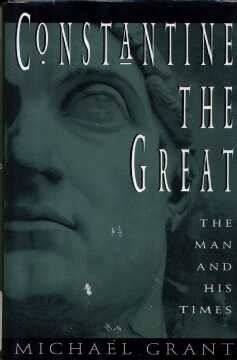
|
His full name was Flavius Valerius Constantius. He acceeded the throne 306. "Almost all the secure information about his age at his death presents him as between 62 and 65 years old" (CtG p15). His father was Constantius I Chlorus (RE43, see Roman), "a powerful, stout, rough and red-faced man ... the son of a goat-herd and of a freedman's daughter ... rising to the position of the praetorian prefect and deputy (Caesar) of Maximian (Augustus from 286) ... Constantius ranked as a 'Roman,' but was really a Danubian provincial ... The name of his daughter, Anastasia, suggests Christian sympathies ... Helena, supposedly a stabularia (a barmaid or landlady of a tavern, perhaps the owner of a guesthouse), may not have been married to Constantius I" (16). "Constantius I Chlorus abandoned or supplemented his connection with Helena ... in 293, when a politically correct marriage to Flavia Maximiana Theodora, the stepdaughter of Maximian, was offered him. We do not know whether he kept Helena with him or not, but Theodora gave him 6 children (including Anastasia ...)" (17).
"Constantius I died while on a visit to Britain (306), and [his son] Constantine was at once hailed as emperor by the troops there. He ruled Britain and Gaul for 6 yrs [to 312] while another claimant, Maxentius, ruled in Rome. In 312 Constantine defeated and killed Maxentius at the battle of the Milvian Bridge [just outside Rome]. Just before the battle he saw an outline of a cross superimposed on a cloud, and this converted him to Christianity; he at once introduced religious toleration, ending the persecution of Christians. In 324 he defeated Licinius, Emperor of the East, and ruled the whole Roman Empire [reuniting it after Diocletian had split it into E/W]. A year later [325] he called the first world council of the Christian Church to meet at Nicaea ([means 'victory] now Iznik, Turkey). In 330 Constantine moved the Empire's capital away from pagan Rome to a new city, Constantinople, built on the site of the village of Byzantium (now Istanbul)" (BN HT p43). At Constantine's death in 337, his 3 sons jointly rule the Roman Empire; Constantine II to 340, Constans to 350, Constantius II to 361.
Byz: Constantine was "little more than a child when his father became one of the 4 rulers of the Roman Empire. As early as 286 the Emperor Diocletian [having decided to share ruling power] ... raised an old comrade-in-arms named Maximian to share his throne. He ... based ... at Nicomedia ... Maximian ... at Milan ... before long, however, Diocletian decided to split the imperial power still further by appointing 2 'Caesars' - generals who, while remaining junior to himself and Maximian ('Augusti'), would also exercise supreme authority in their allotted territories and would ultimately inherit [the Augusti position] ... One of these first Caesars, a rough, brutal professional soldier from Thrace named Galerius, was given charge of the Balkans; the other, to be based in Gaul but with special responsibility for the reimposition of Roman rule in rebellious Britain, was Constantius Chlorus ... For some years all went smoothly enough - years which the young Constantine spent at Diocletian's court ... on his return journey [from a campaign in Egypt] through Caesaria in Palestine ... he made a lasting impression on a young Christian scholar named Eusebius ... we must assume [Constantine] witnessed, in 303, the deliberate burning of the newly completed cathedral at Nicomedia [see br-glas, St. George] - the dramatic inauguration of those famous persecutions that were to rage, scarcely controlled, for the next 8 years. But then, in 305, there occurred an event unparalleled in the history of the Roman Empire: the voluntary abdication of the Emperor. After 20 years on the imperial throne, Diocletian had had enough of power; he now withdrew ... [to his] vast palace ... at Salona (the modern Split) on the Dalmatian coast - forcing an intensely unwilling Maximian to abdicate with him ... Galerius and Chlorus ... were proclaimed Augusti as arranged, but ... appointment of ... the 2 new Caesars was hotly disputed ... Constantine, finding himself passed over and fearing for his life, fled at night from Galerius's court at Nicomedia ... and joined his father at Boulogne ... [joining him on a successful campaign into Britain to drive back the Picts] ... Shortly afterwards, however, on 25 Jul 306, Chlorus died at York; ... [whereupon immediately] his friend and ally ... King Crocus of the Alemanni who was commanding the auxiliary Frankish cavalry, acclaimed Constantine as Augustus in his father's stead ... [support for this spread from there among legions into Gaul]. But Constantine still needed official recognition ... [which he sought from Galerius, who would only affirm Caesar, not Augusti, for Constantine]. For Constantine, it was enough - for the present ... [by 307] Maximian ... had revoked his involuntary abdication of 2 years before, had resumed the purple in defiance of Galerius and had made common cause with his son Maxentius ... in Apr 311, a few days after issuing an edict of toleration in favor of the Christians, ... Galerius ... died [a horrible death, worms, std, leaving] 3 men sharing the supreme power: ... Licinius, one of the late Emperor's [Galerius] old drinking companions whom he had elevated to be his fellow Augustus 3 years before ... his nephew Maximin Daia, whom he had named Caesar in 305 ... and Constantine ... But there was a 4th who, though not technically of imperial rank, had long felt himself to be unjustly deprived of his rightful throne: ... Galerius' son-in-law Maxentius. As the son of the old Emperor Maximian - who had met his end the previous year, by execution or enforced suicide, after an ill-judged attempt in Constantine's absence to raise the legions against him in S Gaul ... War, clearly, was unavoidable ... [with Licinius' consent, he being pressured by Maximin Daia to his E, Constantine marched into Italy in early summer 312 to eventually defeat Maxentius at the Milvian Bridge 28 Oct 312, where he had his vision of the cross] " (33-9). As a result of this great victory, The Roman Senate rewarded him with a triumphal arch, the colossal statue (7x life-size), and the title of Supreme Augustus. "It was in this capacity that he left the city in early Jan 313 for Milan ... [to meet Licinius for negotiations]. Shortly after, Licinius defeated and killed Maximin Daia ... [this left] Constantine in the West and Licinius in the East - where [Licinius] immediately instituted a reign of terror [to eliminate other rival ruling families, killing even Galerius' widow Valeria, Diocletian's Prisca] ... [But it was an uneasy truce, and by 314, the 2 armies met near Cibalae in Pannonia. Constantine won, but left Licinius some territories] ... [But by 320] it was becoming clear that Constantine was determined to put an end to Diocletian's disastrous division of the Empire and to rule it alone ... on 3 Jul 323 [near Adrianople, modern Edirne, the 2 armies again met, Constantine was closing in when Licinius' wife pleaded for his life, which Constantine granted, also to his 2nd Martianus, but] A few months later, both men were summarily put to death" (44-9). Constantine had reunited the Empire under himself and redirected it toward Christianity and away from paganism.
Here's Constantine's descent (CtG p231, enhanced by "The Families of Diocletian, Constantine the Great, Valentinian and Theodosius" in Byzantium, John Julius Norwich, Knopf, 1988, FHL):
- 01 Eutropia m1?. Syrian (Hannibalianus), m2? Maximian I (RE)
- Eutropia and Syrian
- 02 Theodora m. Constantius I Chlorus (RE, he m1. Helena, m2. Theodora, Hmmm JJN shows Chlorus, not Theodora, as child of Eutropia/Hannibalianus)
- Chlorus and Helena
- 03 Constantine I the Great (RE) m1. Minervina m2. Fausta
- w/Minervina
- 04 Crispus
- w/Fausta
- 04 Constantine II (RE)
- 04 Constantius II (RE)
- 05 Constantia m. Gratian (RE, see below)
- 04 Constans (RE)
- 04 Constantia (or Constantina) m. Hannibalianus
- 04 Helena m. Julian (RE), her 1rst cousin
- Chlorus and Theodora
- 03 [Flavius] Delmatius the elder k337 (PS p290)
- 04 [Caesar 335-] [Flavius] Delmatius k. Aug 337
- 04 [Caesar 335-] Hannibalianus k337 m. Constantina, dau of Constantine the Great
- 03 Julius Constantius (k337) m1. Basillina
- 04 [Caesar 351-] Gallus k354 for challenging Constantius
- 04 Julian (RE) m. Helena, his 1rst cousin
- 03 Constantia m. Licinius (RE)
- 03 Anastasia m?. Bassianus m?. Flavius Optatus
- Eutropia and Maximian I (RE)
- 02 Fausta m. Constantine I 'the Great' (RE)
- 02 Maxentius (RE) m. ? dau of Galerius (RE, son of Maximin Daia?) and Valeria (dau of Diocletian [RE] and Prisca)
- 03 Count Gratian
- 04 Valens (RE)
- 04 Valentinian I m1. Marina m2. Justina
- w/Marina
- 05 Gratian (RE) m. Constantia (see above chart)
- w/Justina
- 05 Valentinian II (RE)
- 05 Galla, 2nd wife of Theodosius I (his 1rst wife was Aelia Flacilla)
- 06 Galla m1. Ataulfus Placidia m2. Constantius III (RE)
- 07 Honoria
- 07 Valentinian III m. Eudoxia (sis of Flacilla, see below)
- 08 Placidia m. Olybrius (RE)
- 08 Eudocia m. Hunneric (son of Gaiseric)
- 04 General Theodosius
- 05 Theodosius I (RE) m1. Aelia Flacilla m2. Galla (see above)
- w/Aelia
- 06 Arcadius (RE) m. Eudoxia
- 07 Flacilla
- 07 Pulcheria m. Marcian (RE)
- 08 Euphemia m. Anthemius (RE)
- 07 Theodosius II (RE) m. Eudoxia (Athenais)
- 08 Flacilla
- 08 Eudoxia m. Valentinian III (see above)
- 07 Arcadia
- 07 Marina
- 06 Honorius (RE) m1. Maria m2. Thermantia (both daus of Serena/Stilicho)
- 05 Serena m. Stilicho
- 06 Maria m. Honorius (RE)
- 06 Thermantia m. Honorius (RE)
- 06 Eucherius
son of Valentinian I [RE] and his 1rst wife Marina, Valentinian I son of Count Gratian and bro of Valens [RE], Valentinian I's 2nd wife Justina, their children were Valentinian II [RE] and Galla, 2nd wife of Theodosius I [RE], son of General Theodosius, whose dau Serena m. Stilicho, ...)
Constantine's lineage is referred to as the "Second Flavian House" (p178). Relatedly, Michael Grant's other book The Founders of the Western World shows the 1rst Flavian dynasty (69-96 AD) as including Vespasian 69-79, Titus 79-81 and Domitian 81-96 (p294 FHL).

Michael Grant (from The Antonines at Mustang)
Dates:
- 193-211 RE Septimus Severus
- 218-22 RE Elagabalus, a priest of Sol at Emesa [Homs], unpopular because he tried to institute his religion as official Roman religion, imported black rock, later sent back, but religion stayed in RE as 'Sol Invictus'
- 244-9 RE Philip the Arab
- 253-60 RE Valerian (k. in Persia)
- 253-68 RE Gallienus
- 263 RE34 Gallienus r253-68 forced to evacuate Agri Decumates, the protruding part of Upper Germany (E of Rhine and N of Danube, which RE wanted to close gap between rivers) since Rhenish Franks and joined w/Salian Franks and, behind them, Burgundians against RE (MG p51). But it was the Alamanni (pushing behind THEM) who really forced the evacuation.
- 268 victory of Gallienus (or, as was believed, Claudius II 'Gothicus' r268-70) at Naissus (Nis) halted the immediate threat of the Goths for a time) MG p54. This would have greatly impressed Constantine's family and the boy in his youth and likely figured in his later attempt to link himself genealogically to Gothicus (and claim that title).
- 270 RE36 Quintillus r270, then RE37 Aurelian r270-7
- 27 Feb 272? Constantine born
- 272-3 Aurelian retakes Gaul led ~20yrs as a splinter empire by C. Pius Esuvius Tetricus
- 274 Aurelian retakes Palmyra led ~20yrs " by Empress Zenobia, takes title restitutor orbis 'World Restorer' (see br-doka)
- 274 RE Aurelian forced to abandon Dacia (modern Romania, N of Danube, which had been conquered by Trajan) to Visigoths. Constantine later retook it in 323, but as Julian 'the Apostate' later argued, only incompletely and briefly (MG p58).
- 276-82 RE Probus est. the 1st fortifications that later became known as the Saxon Shore in Britain (PS p69)
- 284 Diocletian becomes RE (succeeding Carinus and Numerian)
- 286 Maximian is made Augustus of the W (as Diocletian divides leadership first into 2 'dyarchs', then later 4 'tetrarchs')
- 288 RE supports Frankish king Gennoboudes as bulwark against other barbarians (MG p51).
- 293 1st Tetrarchy i.e. Diocletian E Augustus (sr) w/E Caesar Galerius, and Maximian W Augustus w/W Caesar Chlorus
- 303 Nicomedia cathedral burned, begins 8yr persecution of Christians
- 305 Diocletian abdicates, also forcing Maximian to (against his will), leaving in 2nd Tetrarchy; W Aug Chlorus w/W Caesar Severus, and E Aug Galerius w/E Caesar Maximina Daia (this spelled trouble, since both were close associates of Galerius, Severus a trusted subordinate and Daia Galerius' nephew! This meant the sons of Chorus [Constantine] and Maximian [Maxentius], who'd both expected to be elevated to replace their fathers, were shut out?! Why did Diocletian agree to this? PS says p115 that Galerius threatened to push him aside if Diocletian [in failing health and sick of politics] wouldn't go peacefully, which Diocletian then did. The troops were shocked and disappointed that Constantine wasn't chosen. Constantine headed W to his father soon after this, surely realizing that Severus would now view him as an adversary and probably try to eliminate him)
- 306 Chlorus dies 25 July, but not before he and son Constantine defeat the Picts of Caledonia (beyond Hadrian's Wall) in the N. On the same day 7/25, his brit troops now proclaim him W Augustus replacing his father, while Galerius accepts him as Caesar only (w/Severus as Augustus). Meanwhile, Maxentius has himself declared W Augustus in Rome 28 Oct 306 (which Galerius rejects, even later allowing Constantine to head S to defeat Maxentius. Maxentius appealed to Rome's vanity by being local RE, no-tax status which Galerius planned to repeal, local Praetorian Guard which both Diocletian and now Galerius had cut, and Chr community by rescinding persecution). So we now have [in order of precedence] E Aug Galerius, W Aug Severus, E Caesar Daia, W Caesar Constantine). Galerius, occupied w/Sarmatian campaign, sent Severus later in 306 to crush Maxentius, but by the time he arrived he faced both Maxentius AND Maximian. Severus was forced back to Ravenna, imprisoned, forced to give up his title and later killed Fall 307 when Galerius marched on Rome.
- 307 Once Maximian had 'come out of [forced] retirement' and been re-intalled as Aug by his son in Rome, Constantine could see 'the tide turning against Galerius' (PS p119) and agreed to meet Maximian at Trier, where he fully joined the 'Herculians' (v. 'Jovians' see PS p90) by m. Maximian's dau (Maxentius' sis) Fausta (putting aside Minervina) in return for Maximian raising him to W Augustus (Sep 307, i.e. Maximian planned to defeat and replace Galerius as E Augustus, w/Maxentius as E Caesar). But Maxentius resented his father's ordering, had he not himself raised his father back to high office!
- 308 A rift developed, and in April 308 Maximian, expecting the army to back him, suddenly turned publicly against his son, pulling off his purple robe and waiting for the soldiers to sieze him. Oops, the soldiers backed Maxentius and forced Maximian N to Constantine in Gaul, warmly rcv'd. Constantine was playing a waiting game (PS p121), consolidating his hold in the W and remaining aloof from Italian turmoil (he'd refused Maximian's request to harry Galerius' troops escaping Italy). But Galerius called a meeting at Carnuntum for Nov 308, and Maximian attended. But he was there unexpectedly confronted by Diocletian and forced to re-retire. At this mtg, the Tetrarchy was again reformulated, with Galerius as E Aug, and his most trusted general Licinius raised ex nihilo to W Aug, w/Constantine and Daia reconfirmed as Caesars (unacceptable to both, since their elevation dates preceded Licinius). Both continued to use the Augustus title (uh oh).
- 309 in the Fall as Constantine headed N to campaign along Rhine, Maximian headed S to Arles, where he announced that Constantine was dead, siezed the treasury and mint, and gave large gifts to his troops i.e. rebelled. When Constantine heard this, he headed S as Maximian moved to Marseilles, more easily defensible. This was a close call for Constantine, who had a relivatively small army of perhaps shaky loyalty. Also, his attack on Marseille failed. What exactly happened is vague, but later propaganda said the citizens betrayed Maximian, turning him over to Constantine, who magnanimously pardoned him (tho he was dead w/in a few months, allegedly a suicide). Constantine now ruled the W alone at Trier, which had come to prominence during the 3C crisis when, as the chief city of the Gallia Belgica province it became the 2nd city of the breakaway Gallic empire (i.e. #1 Postumus at Cologne, #2 Victorinus at Trier, famous Porta Nigra is at Trier, PS 124).
- 310 by summer, 5 men claimed Aug title, 4 recognized each other (Maxentius odd man out). Galerius was sick. He hoped to make it to 20yrs of rule on 1 Mar 312, but d311 of an aweful putrifying disease (which Christians said was God's punishment for his persecutions, similar to Antiochus and Herod Agrippa).
- Apr 311 Galerius issues Edict of Toleration, ending 'Great Persecution', then dies
- Now Maxentius and Daia grew closer as did Constantine and Licinius. Tho Licinius was supposedly W Aug he now focused his attention E in dispute w/Daia, while Constantine marched to confront Maxentius at Rome. In their propaganda war, Constantine championed the Flavian dynasty while Maxentius did the Valerian. Both were bogus as both men were sons of peasant soldiers! Maxentius claimed Mars, Constantine Apollo. This even tho in 306 Constantine had become a Herculian and client of Mars. He later claimed his father was a direct descendant of RE Gothicus, whose patron was Sol Invictus, an E cognate of Apollo (130).
- 28 Oct 312 Maxentius defeated and k. at Battle of Milvian Bridge, NE of Rome (3 left)
Constantine begins using the famous chi [actually Xi] (X) rho (P) symbol on shields
(i.e. first 2 Greek letters in the name of Christ:
Cristou Cristou Christ)
Roman Senate grants him arch, statue, title Supreme Augustus.
- 312-23 Constantine (W) and Licinius (E) uneasily cooperate
- 313 Edict of Milan (Mediolanum) jointly issued by Constantine and [a reluctant] Licinius, and latter defeats (and kills?) Daia at Campus Serenus later in year (2 left)
- 314 Synod of Arelate (Arles, later renamed Constanina by Constantine in honor of Constantine II, in S France near [just W of] Massilia [Marseille])
- 315 Roman Senate grants Arch of Constantine and giant 7x-life statue in forum, both completed and dedicated in this year
- 316 1st Licinian War
- 317 Crispus, Constantine II and Licinianus (Licinius' son) made Caesars
- 318-20 Donatist and Arian disputes
- 320 Crispus defeats Alamanni
- [315 too MG p56] 323, 328, 332 Wars against Visigoths along Danube frontier in Dacia [modern Romania] (added to RE)
- 19 Sep 323 Licinius' wife pleads for his life, granted, but k. a few months later
- 324 2nd Licinian War (Const was helped by Frankish king Bonitus MG p52).
- 20 May - 19 Jun 325 Church Council at Nicaea (homoousios, Nicene Creed)
- Feb 326: Crispus, Licinianus b315, Fausta executed (on Constantine's orders, why? PS says possibly a Crispus/Fausta affair? abortion?)
- 327-8 Helena, 72yo (so b255), makes her famous pilgrimage to the Holy Land (hmm, perhaps to atone for her part in d. of Fausta?)
She'd been given a 'blank check' to build and give out gifts there, part of Constantine's way of celebrating the successful completion of the Nicene Council, churches included Nativity, Ascension, Mamre (Hebron), Tyre, Antioch, Holy Sepulchre (69). Helena probably died in the Holy Land (as one suspects was her wish), the 1rst pilgrim and founder of the pilgrim movement, which continues to this day.
- 328 Constantine II installed at Trier (as W Caesar). Arles renamed Constantina after him. Constantine builds famous bridge across Danube from Oescus (Gigen) to Sucidava (Celieu) 2,437 meters, said to be longest bridge in world, linking RE w/former (no longer) imperial region of Dacia Inferior (Oltenia, Little Wallachia in Romania). He also built a road running N from Sucidava to Romula-Malva (Rechka, near Caracal MG p59).
- 4 Nov 328 ceremony for transferral of capital from Rome to Byzantium (Constantinople)
- 11 May 330 Constantinople 'formally dedicated to the God of the Christians' (Byz 67). Constantine II hailed as 'Alamannicus' in 330 or 331.
- 331-4 series of decrees effectively closing down all pagan temples in the Empire
- 332 Inauguration of Constantinople (also Treaty w/Goths, which lasted 30yrs and led to large cross-border trade)
- 333 Constans made Caesar (but still a youth, so older Constantius appt'd guardian)
- 334 Sarmatian War (N of Dacia). These were nomads who, tho sometimes intermingled w/Goths, were not Germans but spoke an Indo-European (Iranian) language related to Scythian. Many Dacian slaves imported into the RE were Sarmatians. Primary W tribes were Roxolani and Jazyges (MG p61).
- 3xx Church of the Nativity (Bethlehem)
"From the very beginnings of the Christian era this was a sacred grotto, above which, in the 4C, Constantine constructed a large church" (w/hole in floor looking into grotto, This is Israel p68).
- 333 Rachel's Tomb mentioned by Bordeaux Pilgrim, 'covered by a pyramid of stones'
- 335 Church of the Holy Sepulchre built in Jerusalem
This rebuilt church was consecrated in celebration of the 30th year of Constantine's rule, which was 'exclusively Christian' (75). "The Christians celebrated by transferring the presumed remains of St Peter and St Paul from the catacombs of St Sebastian to the 2 splendid new basilicas that Constantine had built near the sites of their respective martyrdoms" (Byz 74). Constantine promoted his 2 nephews, sons of Delmatius; Delmatius jr to Caesar, Hannibalianus to King of Pontus, bringing to 5 the number of Caesars, Fausta's 3 sons having already been so named. This may have been a deliberate attempt "to reduce the Caesars' prestige: w/advancing age [Constantine] was becoming ever more convinced of [his] special divine dispensation ... Never at any time in his life did he consider appointing a 2nd Augustus, as Diocletian had done. But his very reluctance to delegate authority ... imposed on [him] a workload of almost Herculean proportions; and early in 337 he seems to have suspected that he was ill [~65yo]. He had spent the winter in Asia Minor mobilizing his army [in prep for an impending attack by King Shapur II of Persia] ... during which he had shown all the energy, stamina and endurance that had long made him a legend among his men. Then, shortly before Easter, he returned to Constantinople - there to put the finishing touches to the great Church of the Holy Apostles which he had begun a few years before ... [shortly after] baptized by Bishop Eusebius" (75-6).
- 335 Constantine makes plans to devide RE among his sons and nephews; Constantine II in W, Constans in Italy, Pannonia, N Africa, Constantius in E, Delmatius (step nephew) in Thrace, Macedonia and Achaea, and Hannibalianus (also step nephew?) to rule as 'king of king' (un-Roman royal, but provocative to Persia, why?) in a detached borderlands area formed by easternmost provinces between RE and Persia.
- 336 massive prep for coming Persian War (why would Constantine want this, perhaps trying to resolve it before his death? Hmmm, it created decades of chaos and d. for his heirs)
- 336 1st Goth bishop consecrated i.e. Ulfilas (PS p226), 332 treaty w/them lasted 30yrs
- 22 May 337 Whit Sunday noon: Constantine dies
- Sep 337 Constantius travels to Viminacium (Kostolac, Serbia) to meet his bros (Constantine II and Constans), where each took the title of Augustus and agreed on their portions of the empire, later confirmed by the army and the Roman Senate on 9 Sep 337. Constantine II returned to Trier w/no change (W region; Gallicae, Viennensis, Hispaniae and Britannniae), while Constantius got all the E dioceses, being Thracia, Asiana, Pontica and Oriens, incl. imperial capitals Constantinople and Antioch. Constans got Italy, Africa, Pannonia and Moesia, including Rome, Milan, Carthage, Naissus and Sirmium. Since Constans was only 17yo, Constantine II served as his guardian.
- post-337: While he was alive, the Goths respected Constantine and avoided large-scale invasion of the RE, but once he died, they renounced treaties and forced Valentinian I r364-75 and Valens r364-78 to focus much energy on the crumbling N frontiers (Valens died fighting Goths at Adrianople after allowing them to settle in the area, MG p61).
- 338 Gregory of Nyssa born (d395 57yo), great Cappadocian theologian
- 339 Eusebius [bishop] of Caesaria dies (famously the adoring biographer of Constantine)
- 340 Constantine II k. near Aquileia while marching on his bro Constans (PS p293)
- 343 Constans crossed briefly into Britan to suppress a potential revolt (hmmm, perhaps the origin of Geoffrey of Monmouth's Constans (w/bros Constantine, Constantius) in the Arthur story?). He later acquired a reputation for decadent living, short-changing his army, even debauchery and pederasty.
- 350 (Jan 18) the general Magnentius was acclaimed [Augustus] by his troops at Autun, troops led by Marcellinus, cmdr of Constans' bodyguard (294). Shortly after, Constans was murdered while fleeing S at a fortress called Helena in the Pyrenee foothills. As Magnentius headed SE to contest w/Constantine II, sis Constantinia in Rome had Vetranio (Constans' magister peditum i.e. master of infantry) proclaimed emperor (Caesar, tho HE called himself Augustus) there. Constantius initually supported this, since he was tied down w/Persian battles. But later he made Vetranio retire and named his cousin Gallus Caesar instead (thinking him easier to control). The armies of Magnentius and Constantius met at Mursa fortress NW of Sirmium on 28 Sep 351 and, while losses were heavy on both sides, Constantius was generally thot the winner.
- 353 Magnentius put down by Constantius II at Mursa Major (Osijek)
- 354 Constantius orders the murder of Caesar Gallus, whom he'd raised Mar 351
- 357 Constantius' belated triumphal adventus into Rome in celebration of his victory over Magnentius
- 361 Constantius II dies (he was sole ruler of RE 353-61)
- 361-4 REs Julian the Apostate and Jovian
- 364-75 RE Valentinian I, redivided RE between himself and his bro Valens
- 380 Shrine of the Ascension built on Mount of Olives
- later Byzantines built 'Tomb of the Patriarchs' (Cave of Machpela, Hebron), the Church of the Annunciation in Nazareth (comemmorating where Mary received Gabriel's announcment), (Antonio Barluzzi's) Church of the Transfiguration atop Mt. Tabor, Elijah's altar statue atop Mt. Carmel (near Haifa's Carmelite monastery)
- 390s brief reunification of RE under Theodosius I, but then redivided forever, W fell 476
- 395 Theodosius I dies
- 395-638 Byzantine rule of Holy Land
"Constantine's dream of spiritual harmony throughout Christendom was not to be achieved in his lifetime; indeed, we are still awaiting it today" (Byz p74).
Charles Norris Cochrane, in his 1940 classic Christianity and Classical Culture, says that after the failure of Octavian's (Augustus') attempt to use his position as 'dictator' to restore the republic (so HE claimed, many have disputed this as being mere self-serving cant on his part) i.e. ending with the '5 good REs' in the 2C, his "principate [i.e. dictatorship] ... the creation [of which] was the personal achievement of a man whose signet-ring bore an image of the Sphinx [i.e. symbolizing oriental despotism] ... [and was] originally an intrusion into the machinery of [republican] govt ... was destined to be transformed, 1st into the naked military and bureaucratic absolutism of the pseudo-Antonines [i.e. the ones immediately AFTER the real Antonines] and later into the theocratic dynasticism of Diocletian and Constantine" (3-4). His main thesis is that "the history of Greco-Roman Christianity resolves itself largely into a criticism of [Augustus' vision, i.e.] ... that it was possible to attain the goals of permanent security, peace and freedom [i.e. peace, prosperity, liberty, the main goals of politics] thru political action [alone], esp. via submission to the 'virtue and fortune' of a[n all-powerful] political leader. This notion the Christians denounced w/uniform vigor and consistency. To them the state, so far from being the supreme instrument of human emancipation and perfectibility, was a straight-jacket to be justified at best as 'a remedy for sin'. To think of it otherwise they considered the grossest of superstitions" (viii, i.e. they were [Christian classical liberal] 'conservatives' to the pagan [fascist] 'left-liberals' in modern terms).
From DoKA (Appendix: The Blood Royal: A Fancy), author Geoffrey Ashe shows some evidence for the following descent:
- Maximus
- Severa, 1rst wife of Vortigern (2nd was a Saxon wife)
- ? (dau of Vortigern and 2nd [Saxon] wife) m. Arthur-Riothamus
- Cerdic (Ashe: Elesa is likely not Cerdic's father, since no Saxon would give his son a Celtic name like Cerdic)
369: Roman general Theodosius (later RE 379-95 T. I 'the Great') drives Picts (i.e. Scots) and Scots (i.e. Irish) out of Roman Britain. 383: Magnus Maximus, [self-appointed] Emperor in the West (to 388, when he was captured and executed by Theodosius) conquers Gaul and Spain. Roman legions begin to leave Britain [needed for defense closer to Rome]. (BN HT).
Here are some other excepts from DoKA (from brits.html on the period of Post-Roman British Independence): Geoffrey of Monmouth shows rulers Constantine III, Constans, Vortigern (name means "overking", called "bad" by Geoffrey of Monmouth, m. 429 dau of Saxon chief Hengist 36, when Saxon brothers and chiefs Hengist and Horsa come to Britain, they name their gods Woden, Freya, ... Vortigern is disappointed but still enlists their help, m. earlier a dau of Maximus, first acknoweledged high king of Brits, reigned c. 425-?, still living 455, pro-Pelagian, in 5C blamed for Saxon (and Angles, Jutes) invasion (446 citizen appeal to general Aetius, last of the great Roman soldiers, still fighting for Valentinian III (murdered 455), a few yrs yet before his defeat of Attila's Huns, looting raids continued into the 450s), to which Arthur responds as British hero, Vortigern's son Faustus b. 405-10, grandson Riagath or Riocatus), Aurelius Ambrosius (son of Constantine, in 460s fighting successfully to contain Saxon barbarians 50), Uther (son of Constantine), Arthur (mythical? his earlier 'British kings' are imaginary, misplaced in time, or Romans mistakenly said to be British, says Ashe p. 31, b. c. 430s, enthroned c. age 15, reigns 25 yrs, early 40s when he "departs for Avalon" 92, all guesses). No doubt many leaders were simply warlords or military bosses who gained notoriety and power by fighting barbarian invaders. Ashe discusses Cunedda or Kenneth, Ceredig (Coroticus), Coel (mythical Old King Cole, father of Helena, mother of Constantine), Ambrosius Aurelianus. Geoffrey's Aurelius Ambrosius, Arthur's uncle, is based on him. One gentleman (Roman prefect, bishop of Clermont, saint) named Sidonius Apollinaris, living at Auvergne, is well-known due to his many contacts and writings. The heretic (so ruled 418) Pelagius had come from Britain (Ashe: "his social outlook was left of center" 35). By 446 Britain was solidly Catholic. St. Ninnian, British missionary to country folk, studied in Rome 390s, d. 432. St. Patrick, b. c. 390.
DoKA p? (MBKQ p? says Helena probably not Coel's dau) explains:
- Coel P84 (not "Old King Cole" Coilus/Coel P77 son of Marius, gson of Arviragus)
- Helena m. Constantius I Chlorus
- Constantine I the Great P86
From ECH: "In a general reading of Church history, a different impression is gained from the Christian controversies of the first 3 centuries than from those which succeeded them. In those first 3 centuries, Christian teachers and their schools seem to be searching, in their various ways, for the true meaning of their religion and for the way to practise it. Later, the use of words and logic assumed greater importance. The break-point appears to come at the time when Christianity was accepted as an official religion in the Roman Empire. Some Christians today hold the view (as did many living at the time) that, when Christianity [was legalized], it ceased to be Christianity. It became [merely] a sign of respectability for those who wanted to advance in the world. It incorporated the legalities of Imperial Rome into its ethics; virtues and vices, punishments and rewards were regulated, as in a legal system. But in the eyes of the 'orthodox,' the survival of the Divine Institution through the Dark Ages and the crumbling of civilization was only made possible by this [institutionalization]" (149).
From HoR: In his City of God, Augustine "undermined patriotism ... [offered] a distinct unhopefulness about the future of any and every terrestrial state ... [his] pessimism carrie[d] gloomy implications for the future of Rome's civilization - or rather, of the human endeavor that was needed to maintain it. His doctrine of grace, adapted from St. Paul, maintained that by our own unaided will, w/o God-given aid, human beings are incapable of achieving anything at all [see br-acfl]. It was a decisive break with the optimistic, humanistic attitudes of the classical world. And it was deeply resented by men such as Pelagius ... who, in the spirit of Cicero, laid strong counteremphasis on individual effort ... [later] suppressed ... Augustine had cut Rome firmly down to size. Its interests could no longer be held paramount ... indeed, as he grew older, Augustine came more than ever to reject any identification between Christianity and empire. In terms of world politics, he did not prevail because the identification had come to stay. But his influence was widespread, and his refusal to believe in a Christian empire was a part and parcel of the West's failure to defend itself against its enemies and stave off its own collapse" (460-1).
From OIH: "After the death of the Emperor Theodosius I in 395, divisions between the Latin and Greek halves of the empire became more evident. The east far outshone the west in intellectual achievement, prosperity, and the number and size of its cities ... Not only the resources but the ideological backing for imperial authority were stronger in the east, where the Hellenistic heritage reinforced acceptance of the imperial cult and the trappings of autocratic power ... In the east the propaganda of scholar-bishops and the proselytizing of holy men reinforced allegiance to the ideal of a God-given Christian empire, while in the west Christianity was less firmly established and undermined attachment to the empire by offering an alternative to imperial service [i.e. RCC]" (1).
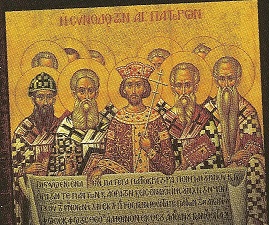
from a FT ad for the DVD 'The Creed: What Christians Profess, and Why It Ought to Matter', writer Tim Kelleher ($20). Hmmm, name these faces ...
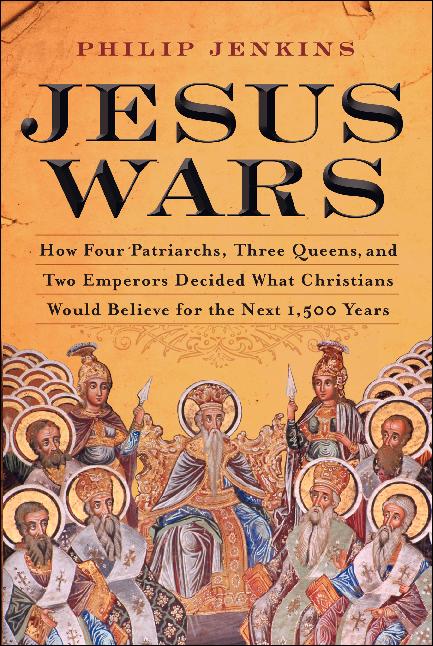
d/l from internet. Name these faces ...
In 'The First Great Schism' (B&C Jan/Feb 2011), Robert Bruce Mullin rvws Philip Jenkins' 2010? bk Jesus Wars: How 4 Patriarchs, 3 Queens, and 2 Emperors Decided What Christians Would Believe for the Next 1,500 Years. Interestingly, the cover is depicted in Russian iconography style (scan sometime if possible). He says 'the period between 400 and 600 saw the most profound transformation of the Christian world. They lack the clarity of the (commonly held view of the) patristic era ... [and] the closure of the 4C, during which Christians wrestled with the nature of the Godhead, concluding w/the Trinity ... Rather this was the era when the question of the person of Christ was passionately debated ... humanity / divinity. At the heart of this debate were 2 competing visions from 2 of the great ancient centers of Christianity. The Egyptian church of Alexandria - by tradition founded by St Mark - reflected the philosophical vision of Plato. The one was the key and always superior to the many. God was one and hence the unity of the Father and the Son was paramount. The humanity of Christ, tho real, was ephemeral. Just as Christians of this persuasion read Scripture by means of allegory, quickly passing by the literal meaning to discover the more central spiritual meaning, so too did they view the person of Christ. It was his divine nature that was central. In contrast stood the great Syrian church of Antioch, long associated w/St John. They were Aristotelian, where the meaning was in the details (the many). They read Scripture as a historical record, and it revealed the full humanity of Jesus. The schools clashed on the Virgin Mary; was it correct to call her Theotokos i.e. God Bearer, or Mother of God? Alexandria said yes, Antioch said no, creating decades of conflict. Neither triumphed, since the 430 Council of Ephesus rejected the extreme claims of Antioch, while Chalcedon 451 rejected Alexandrian single-nature (Monophysite) theology, declaring correct or orthodox Christ as 1 person w/2 natures, still held by RCC, Orthodox and traditional Protestants. Unfortunately it also divided the Christian world. The Egyptian [Coptic] church rejected Chalcedon, persisting in dissent to this day (also influenced Ethiopia church). But church of Antioch (Nestorian) rejected Ephesus and, leaving the RE, headed E to China (influencing Persia and India along the way). This eclipse of Alexandria and Ephesus magnified the influence of Rome and Constantinople (latter had formerly been a minor player ecclesiastically, if not politically). The Western church hadn't played a major role in the debates, but it was Pope Leo's letter ('tome') on Christ's 2 natures that provided the language for Chalcedon and also solidified the role of the papacy (i.e. the bishopric of Rome) as an office of doctrinal primary. This weakening of the E RE in turn set the stage for Islam's meteoric 7C rise, sweeping in Antioch, Egypt as well as Jerusalem and N Africa w/in 2 decades of Muhammad's death. Christianity was now closely linked only w/Europe. Jenkins ponders 'what might've been' had we stayed unified? The tale includes plenty of violence, scheming and intrigue e.g. monks as 'holy head-breakers'.
The same book is rvw'd in 'God and Man at Chalcedon' (tAC Jan 2011) by Bruce Chilton. He notes that 1979 saw the beginning of the so-called '3rd Quest' for the Historical Jesus, but Jesus controversies have been raging far longer. RE Constantine called Nicene Council in 325 to solve this issue, and its result was the doctrine of homo-ousious (same, not just similar, essense or being). But it continued to fester. The Antiochenes managed to have one of their own named bishop of Constantinople (hame?), but he was later forced out by the Alexandrians (anxious to maintain their high standing w/in church). Antioch's 2nd try was Nestorius, who began by driving out Arians. Unfortunately he then overreached (a common theme in this book) by attacking the title Mother of God for Mary (a beloved local custom). This brought the wrath of the powerful sis (name?) of the RE (name?), but also of Cyril, bishop of Alexandria. This lead to Nestorius' condemnation at Ephesus 431 (called by RE Theodosius II). Cyril later compromised w/Leo's 2 natures language, but his Monophysite logic persisted. His own handpicked successor Dioscuros of Alexandria overreached too; the then bishop of Constantinople (name?) was harried out of office and later killed. Chalcedon 451 was called by the new, vigorous RE Marcian r450-7. This united the W at the cost of disunity in the E (which considered the W subsidiary to themselves, mere upstarts). The E splintered into Nestorian, Monophysite and Orthodox churches w/widespread violence, rendering them vulnerable to Arian Vandals, Huns, Sassanids of Persia and later Muslim conquerors. The book makes clear that many debates about history are theological at base. The doctrine of atonement relies on Jesus' divinity.
So we have:
- 4 Patriarchs
-- Pope Leo I
-- Antioch's Theodore of Mopsuestria (Nestorius, ToM's student and bishop of Constantinople)
-- Cyril, bishop of Alexandria (eloquent, powerful and ruthless)
-- Dioscuros of Alexandria
- 3 Queens; name? sis of RE name?, x, x
- 2 REs; Constantine and Marcian (but also Theodosius II)
Contemporary (4C) Events (mostly from BN HT and CHME):
- cf KCoel for earlier events
- 303 Diocletian orders a general persecution of Christians, 'Era of Martyrs' 303-5 'the harshest Roman persecution of the church' (CHME p26)
- 305 Diocletian abdicates (and makes Maximian do so) -> power (vacuum) struggle
- 306 Constantius dies in Britain, son RE47 Constantine named RE by soldiers (to 337 31yrs)
- 308 Maxentius, son of Maximian, W RE to 312 4yrs
- 311 Donatism splits N African churches from now til 5C
- 312 Battle of Milvian Bridge outside Rome, Maxentius k., Const converted to Christianity
- 313 Edict of [Milan] Toleration proclaimed i.e. Christianity legalized
- 317 N China overrun by nomads, brks into 16 kingdoms, E Jin Dyn to 420 103yrs est. in S, rules from Nanjing (Hyby p80)
- 320 Chandragupta I ruler of N India to 330 10yrs, Gupta Dynasty fndr (dominated India for 200yrs, Hyby p80); Arian Controversy 320-64 44yrs, by 350 Arians outnumbered Christians in E RE
- 324 Constantine reunites RE
- 325 REConst calls 1rst Christian Church council at Nicaea (now Iznik, Turkey; began 4 Jul), recognizes 'Trinity' ('homo-ousius' = same essense) and rejects Arianism (Arius was an elder at Alexandria)
- 327 Constantine tries to reinstate Arius, but Athanasius objects
- 329 St Basil the Great of Caesaria born (d379 50yo), Gregory Nazianzus born (d389 60yo), both great Cappadocian fathers, opposed Arianism
- 330 Constantine moves RE capital to Byzantium (now Istanbul, Turkey), renamed Constantinople (and away from pagan [and strategically less important] Rome), Helena dies (b255 75yo), Gregory of Nyssa born (d394 64yo), Basil's bro, also a grt Capp. father
- 336 Arius dies (b. c250 86yo) sparked Arianism heresy
- 337 Constantine dies, baptized on deathbed, joint rule by 3 sons; Const II to 340 3yrs, Constans to 350 13yrs, Constantius to 361 24yrs
- 339 Eusebius of Caesaria dies (b263 76yo), wrote 1st History of Christianity; St Ambrose b. c339 (d397 57yo) Governor, then Bishop, of Milan (switched 370s), confronted RE Theodosius on several occasions (Chr mob burns synagogue, RE k. 7k after 'Nike' riot), 'Christian Empire' developing
- 345 St Jerome born (d420 75yo), monk and scholar, translated [Hebrew/Greek to] the [Latin] Vulgate (took 22yrs, 383-405), ofcl RCC Bible for 1kyrs
- c347 St John Chrysostom 'Golden Mouth' born (d407 60yo), priest at Antioch, Syria, later overseer of Constantinople, criticized Empress Eudoxia (wife of RE Arcadius)
- 350 Christianity reaches Ethiopia, sometime during 4C monks copied the oldest known copies of Christian Scripture aka Codex Sinaiticus
- 351 RE50 Constantius (once again) reunites RE, meanwhile (consol? in Rome?) Julian attempts to reintroduce paganism to RE
- 354 St Augustine born (d430 76yo) Bishop of Hippo in N Africa
- 360-3 RE51 Julian the Apostate (Constantine's nephew)
- 361 Synod of Alexandria called by Athanasius, E/W agree God is '3 persons who share same essense' (CHME p32, ironically, Julian's anti-Chr united E/W)
- 363-4 RE52 Jovian[us], surrenders Mesopotamia to the Persians, RE split in 2
- 364 W RE53 Valentinian I to 375 11yrs, E RE53 Valens to 378 14yrs
- 367 Athanasius' (of Alexandria d373 aka 'Black Dwarf') Easter Letter i.e. list of NT bks, later confirmed at 397 Synod of Carthage, also wrote bio of St Antony
- 369 Roman general Theodosius drives Picts and Scots out of Roman Britain
- 370 Huns from C Asia invade Europe
- 372 Buddhism introduced to Korea (from NE India, Nepal)
- 375 W RE54 Gratian (co- 367-) to 383, W RE55 Val II to 392 (co- to 383)
- 378 RE Valens defeated and k. by Goths at Battle of Adrianople; c378 Cyril of Alexandria born (d444 66yo)
- 379 E RE54 Theodosius the Great to 395, (briefly, til his d.) unites RE 394 (as RE57)
- 381 1rst Council of Constantinople, 2nd general council (of 7 accepted by E/W), denounced Apollinarianism [Jesus had no human mind] and apprived Nicene Creed
- 383 W RE (usurper) Magnus Maximus, conquers Spain and Gaul, Roman legions begin to leave Britain
- 388 Theodosius captures and executes Maximus
- 391 Theodosius declares Christianity the Official Religion of the RE
- 393 last Olympic games of the ancient world, held at Olympia, Greece (Hyby p81)
- 395 W RE58 (11yo) Honorius (Theodosius' son) to 423 28yrs, bro E RE58 (18yo) Arcadius to 408 13yrs (Michael Grant: both unintelligent, incompetent), Stilicho (1/2 Vandal Roman general to 397) drives Visigoths out of Greece
- 397 (Nov 11) St Martin of Tours dies (b?), 'the great Gallic [French] saint' (OoC p74)
- 401 Pope Innocent I (to 417) claims universal jurisdiction over Roman Church for 1rst time ('popes' only Bishops of Rome before that)
- cf Childrc1 for later events
'The great classicist Theodor Mommsen wrote: 'In the development of Christianty, Africa plays the first part. If it arose in Syria, it was in and thru Africa that it became the religion of the world'. Latin Christian traditions developed in Carthage rather than Rome, and Africa was the home of such great early ldrs as Tertullian [160-225], Cyprian [d258] and Augustine [354-430]. By the late 5C N Africa had 5-600 bishoprics, while monasteries were a familiar part of the local social landscape. Even after long struggles between rival Christian sects, N Africa in the century after 560 was a potent center of spiritual, literary and cultural activity ... Yet w/in 50yrs of the completion of the Arab conquest in 698' (LHC p228) it had collapsed.
In the 4C Christians gained something they'd never had before - earthly peace and power. But this meant some were attracted to the faith for bad reasons. Also, many began to identify Christianity with earthly institutions v. the invisible community of all true believers. The institutional aspects of the church became overly important, and the gospel became diluted. Others fled to the desert and lived as monks (CHME p34). This makes us wonder what the proper relation is between 'Christianity and Power', 'Christ and Culture'. Latter the title of Richard Niebuhr's famous book in which he examines 5 possible answers: 1 Christ against Culture, 2 of, 3 above, 4 in paradox with and 5 transforming.
2 preaching methods arose in the 3C; one at Antioch, Syria; the other at Alexandria, Egypt. The former (e.g. Chrysostom) searched for author's meaning, the latter (Origen, Ambrose) search for secret, spiritual [allegorical] truths that were often unrelated to the text's original intent (CHME p40).
After the 381 Council of Constantinople, disputes over the relation of the divine and human in Jesus Christ disrupted the [Greek] East ... As Bishop of Constaninople 428-31, Nestorius objected to the Latin [RCC] habit of calling Mary Theotokos or 'Mother of God' ... but Cyril of Alexandria and the Egyptian monks opposed Nestorius. Both sides appealed to Rome, which in 430 voted against Nestorius, and in 431 the Council of Ephesus summoned by the RE (name?) deposed him, sending him back to Antioch, condemning his books in 435 and exiling him to Upper Egypt 436 ... Nestorius apparently believed in 2 different natures and persons of Christ, with conjunction v. union between them. He championed the humanity of Christ in opposition to the later Monophysites. The controversy raged on until the 451 Council of Chalcedon opposed both Nestorianism and Monophysitism by declaring '1 Person, 2 Natures w/each nature preserving its own characteristics w/o diminution' (HCW p95-6).
Sources:
- CtG = Constantine the Great, Michael Grant, Charles Scribner's Sons, 1993 (FHL).
- DoKA = The Discovery of King Arthur, Geoffrey Ashe (see br-doka.html)
- MBKQ = The Mammoth Book of British Kings and Queens, Mike Ashley, Carroll & Graf,1999.
- Byz = Byzantium, John Julius Norwich, Knopf, 1988, FHL.
- ECH = Early Christian Heresies, Joan O'Grady, B&N, 1985, Mustang
- HoR = History of Rome, Michael Grant, Scribner's, 1978
- OIH = The Oxford Illustrated History of Medieval Europe, ed. George Holmes, 1988, FHL
- CRE = Chronicle of Roman Emperors, Chris Scarre, Thames & Hudson, 1995, Mustang
- tAR = The Ancient Romans, Don Nardo, Lucent, 2001, FHL
- BN HT = History's Timeline, Barnes & Noble, 1981, own.
- KRGG = Knights, Romans, Greeks and God, Brian Daniel Starr, Xlibris, 2011, own.
- CHME = Christian History Made Easy, Dr Timothy Paul Jones, Rose, 2005, 165pp, own.
- LHC = Lost History of Christianity, Philip Jenkins, HarperOne, 2008, 315pp, Mustang.
- Hyby = History Year by Year, DK, 2013, FHL.
- HCW = History of Christianity in the World, Clyde L Manschreck, Prentice-Hall, 1974, own.
- OoC = The Origin of Christmas, Joseph F Kelly b1945, Liturgical Press (RCC St Benedict), 2004, own.
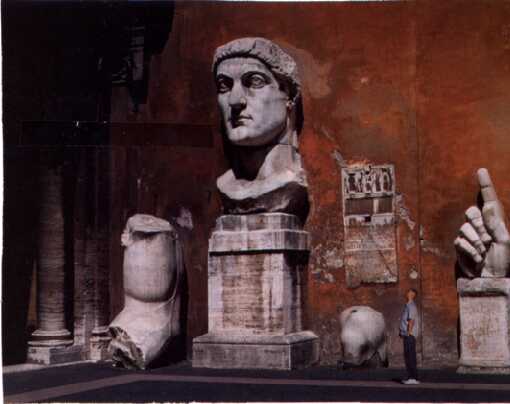
Remnants of the famous huge statue, which once stood in
his basilica at Trier [Augusta Trevirorum], but is now in
the Museo dei Conservatori in Rome, from a magazine ad!
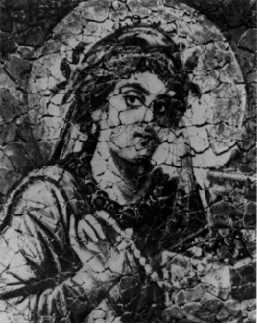
Painted portrait from Trier thought
to represent Helena (CtG)

Helena (from Paul Stephenson's bk C:RE,CV)
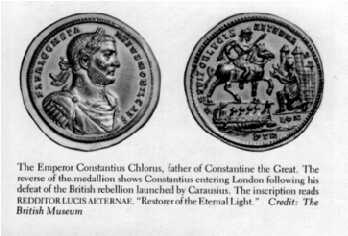
Constantine's father (from DOKA)
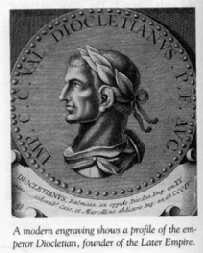
Diocletian (tAR p76) |
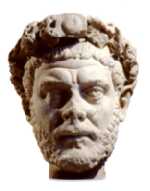
Diocletian (AR p46) |
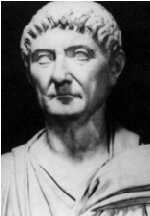
Diocletian (FoRE p31) |
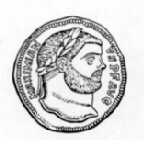
Maximian (CRE p196) |
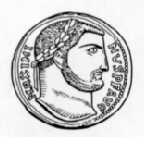
Maximinus Daia (CRE p206) |
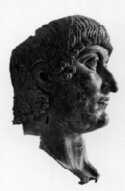
Constantius II (CRE p224) |
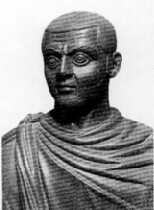
Galerius (CRE p206) |
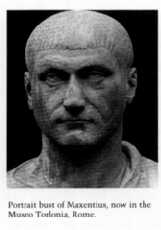
Maxentius (CRE p208) |
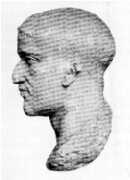
Chlorus (CRE p209) |
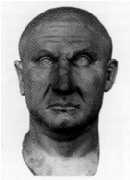
Licinius (CRE p215) |
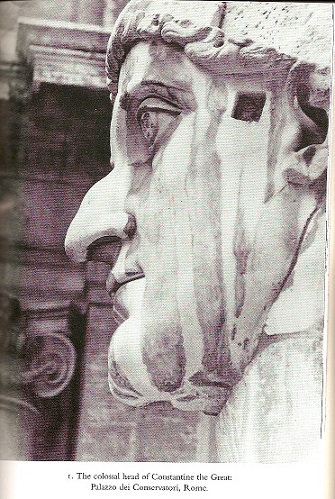
From Michael Angold's 2001 Byzantium p110+ (own)
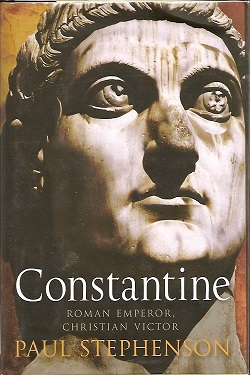
cvr of 2010 Paul Stephenson bk (SPL)
Constantine: Roman Emperor, Christian Victor
Paul Stephenson (U of Durham, RHS)
Overlook, 2010, 358pp, SPL
Intro 1
Constantine was b. c272 at Naissus, a military settlement 65 miles S of the Danube frontier. In the same city and around the same time, Claudius II Gothicus RE r268-70 died of either smallpox or measles. Constantine would later claim he was related to Gothicus (i.e. that Claudius, Quintillus and Crispus were bros, and Crispus had a dau Claudia who m. Eutropius, the noblest man of the Dardanian folk, and of them Constantius was born, who became 1st a bodyguard to the RE [his grt uncle] Claudius II, then a tribune, later governor of Dalmatia), but PS says no. The worst of that plague was 251-66. Chlorus became Praetorian Prefect in 289, RE Maximian's top lt, in charge of the western army. Diocletian was E RE. At that time he m. Maximian's dau Theodora. PS says Const's reason for embracing Christianity was to guarantee victory in battle (5). Hmmm, this is conjectural and casts a Machiavellian shadow over him. So already in the intro he's tipped his hand. He says Gibbon considered Constantine's conversion 'genuine and destructive', while Burckhardt saw it as merely 'a cynical ploy'. PS says its healthiest to find a middle way, but are these really polar opposites? How about 'genuine and constructive', w/later destruction of RE due to non- or anti-Christian factors? PS believes his original contribution is focusing on the army and its 'religio', which Constantine changed to 'a triumphalist brand of' [and] 'a militant interpretation of' (6) Christianity (incl. 'sponsoring an institutional church that could propagate and sustain the religion' 5-6, w/himself as 'Pontifex Maximus' or chief priest), remarkably making it the 'faith of the legions' (5). PS admits that Chr pre-Const was not uniformly pacifist, but he says Constantine's involvement 'altered the nature of the religion, privileging men and their interests' (6, hmmm, sounds eerily like modern left-liberal accusations, and also left-Chr theology and actions).
I: Faith and Power in the 3C
1 Religion in the Later RE (13)
"The historical magnitude of Constantine's life is explained by one fact: he was the 1st RE to convert to Christianity ... he saw the god of the Christians as the bringer of victory, the 'greatest god' [among other things e.g. personal savior etc.] who had hitherto been misidentified as Zeus, Jupiter or the Sun. Const's militant interpretation of Christianity was founded on the Roman understanding of the interactions between faith and power" (13, i.e. if you have the right faith [esp. rituals], you'd have 'wonder working' power). Here PS distinguishes 3 aspects of Roman 'religio' i.e. 1 official religious life of the army as a whole, 2 that of each unit, and 3 that of each soldier i.e. private religious devotion e.g. Mithraism and many others. PS speculates that Const, having been brought up in army camps, was perhaps a Mithraist (37).
2 The Rise of Christianity (38)
A period of exponential growth of Chr occurred in the later 3C, from ~1M in 250 to ~6M in 300 to ~34M by 350 (38)! Since the total pop. of the RE remained ~constant at ~60M during this time, Chr went from a tiny minority to a majority in the RE. He cites Rodney Stark's 1996 Rise of Christianity and also W. Frend's 1984 bk of the same name. He explains Chr's rise in terms of 'sex, health, and arithmetic' (39) i.e. women got a better deal, all Chr were better cared for by other Chr, and Chr prohibited exposing unwanted babies (a widespread Roman practice at the time). PS notes interestingly that, after WWI, 'the pacifist line was expounded most fully in English by C John Cadoux, who intended 'to show how strong and deep was the early Chr revulsion from and disapproval of war'' (49). PS later says 'but a coherent pacifist ethic can't be identified in the NT, because Jesus never addressed the matters of military service or killing in war' (50). Marcion was put off by the God of the OT and advocated distinguishing him from Jesus of the NT. Christians were actively campaigning at least as early as 173 AD in the army of Marcus Aurelius in his Danube wars i.e. the famous 12th Legion Fulminata who prayed for rain and were answered (54-5). Indeed, Tertullian's main beef against military service was NOT the violence but the required participation in pagan military rituals (56). The 1st systematic persecution of Chr projected across the entire RE was under Decius r249-51 (60). Later Byzantine stories of great warrior saints e.g. Mercurius 'became notable only later ... [when] a Christian empire [was] in need of warrior saints' (60, hmmm, so doxos followed praxis, PS sneers). PS says (like Bart Ehrman) there were 'many Chrs' i.e. 'the Chr Church was a loose agglomeration of disparate communities, and many views could be expressed' (61) i.e. before Const began enforcing orthodoxy and made it dangerous to differ w/it.
3 The Unconquered Emperor and his Divine Patron (62)
"The rise of Chr coincided w/a sustained period of crisis for the RE. It was held by many to be the cause of the crisis ... [hence] for the 1st time in mid-3C a systematic persecution of Chr thru-out the RE [under Decian, earlier Nero one localized to Rome]. At the same time, in response to the crisis but in fact contributing far more effectively to its perpetuation, a dramatic increase in the political power of the army [at the expense of the Roman Senate]. Thru the 3C the army was the only instrument of state that could raise up and strike down REs ... [=> instability] In the half-century between the end of the Severan dynasty (193-235) and the foundation of the Tetrarchy (284) ... more than 50 men claimed the title RE. 22 of these were universally recognized, of which the vast majority were both acclaimed and later murdered by troops under their cmd. All but 2 of the recognized REs who reigned 251-84 d. this way, exc. Valerian r253-60 k. by Persians and Claudius II Gothicus r268-70 who d. of measles or smallpox (62). Severan success against the Parthians ('a large and soft target') led to the rise in the mid-220s of Ardashir, satrap of Fars [Farsi language of Iran], leading the new Sassanian Persian empire, a much bigger military threat to the RE (his son Shapur I r241-72 k. Valerian, and Shapur's son Narses was defeated by Galerius [w/Constantine in his army]). Goth armies were gaining sophistication by copying Roman tactics and weapons, while 2 internal provinces had split off into splinter states in Gaul and Syria, having been renegades for 2 decades before they were subdued by Aurelian (64 i.e. Gaul led by C. Pius Esuvius Tetricus def. 272-3, Palmyra by Empress Zenobia def. 274). This instability led to military costs which crippled the state economy (i.e. the part monetized by the govt, only a 'small fraction' of the whole 64). The many ephermeral REs would focus on funding the army and neglect all else (i.e. failure to invest in civil society), meanwhile large swaths of lands (capital) were destroyed and an epidemic in the 250s-60s k. perhaps 30% of the RE pop.! REs inevitably resorted to inflation and higher taxes, which drove a vicious cycle downward. The rise of the army began in the Severan dynasty (66). Hmmm, Septimus Severus d. after an 18yr reign in York on 4 Feb 211 (note -> Bamburgh.html). No reign would last as long til Diocletian's (67). Many REs were murdered by their own troops for either fighting too much (bigging down, few rewards) or not enough (not enough plunder)! As Tiberius had said; 'handling an army is like holding a wolf by the ears' (69, or 'a tiger by the tail'). Most of these REs only went to Rome to secure recognition by the Senate, but then spent most of their reigns at the other imperial centers; Trier, Sirmium and Sardica near the Rhine and Danube frontiers, Salonica and Nicomedia on major E-W roads, and Antioch, gateway to Persia (71).
In addition to practical economic (plunder) incentives, REs also sought emotional and even spiritual bonds w/their troops (71). This became 'the core of the army's religious life' and lead to the Roman 'Imperial Theology of Victory' (coined by Jean Gage c1935 i.e. like Cornwell's discussion of Dane/Saxon ideas of 'may the most powerful god[s] win', i.e. if your god is most pwrful, you'll win AND if you win, your god is most pwrful, and their negations). During the 3C, there was no longer a balance between human virtus and divine felicitas, but rather one observes an absolutist theology [of Victory] involving the notion of an invincible (invictus) RE, possessed of a supernatural virtus precuring an eternal and universal Roman victory (73). This statement was from Rudolph Storch, who also astutely observed that it mirrored both a decline in Roman military fortunes and the rise of monotheistic beliefs. It was essential that REs be seen as being backed by the 'greatest god' (summus deus), and Constantine later made the most of this way of thinking with the Christian God (in sincerity, not cynicism). 3C Roman gods were Jupiter Invictus, Mars I-, (son of Jupiter, bro of Dionysus) Hercules I- and Sol I- (of Mithraism, 76). 'On 2 occasions, Sol is identified as Elababalus, the Syrian god worshipped at Emesa [Homs] in the form of a black stone, probably a meteorite (and thus common to the worship of Cybele, Sol Elagabalus and the later god of the Muslims)' (77). PS says 'Aurelian deserves careful consideration, for [he] presents a case study of the imperial theology of victory in action and serves as a model for Constantine's [later] actions' (79). He was a successful cavalry cmdr known for stern (even brutal) discipline (he used the 2-tree split on errant soldiers). PS notes that 'brutal imposition of authority was more admired than feared by the Romans' (80), but this was noteworthy even for them. AlexGrt had also been known to use this technique (undoubtedly why Aurelian did too). Aurelian restored RE's integrity, defeating usurpers in Gaul and Palmyra and taking the title 'World Restorerer' (see doka). He attributed his victories to Sol Invictus. Interestingly, a later (unreliable) pagan historian in Historia Augusta (written late 4C) tried to claim divine backing (by Sol Invictus) for Aurelian's feats (probably trying to match Eusebius' claim for Constantine by the Christian God). (This 'battle of the historians' is still ongoing!). PS says his 'consideration of the conversion of Constantine will [show how] Sol and Christ might easily [have been] regarded as cognates [as Apollo and Sol were], w/veneration of Sol treated as a stepping-stone to the fuller appreciation of Christ (85).
4 The Tetrarchy (87)
Constantine used this Roman 'imperial theology of victory' to fuse the vigor of the Christian faith w/the power of the army (87, it would be easy to assume cynical motives, but this would be to impose modern sensibilities, 84). Diocletian, acclaimed RE by his troops near Nicomedia in 284, realized he needed help ruling, and seeing that earlier attempts to involve sons had failed many, and having only 1 dau, he named his trusted subordinate Maximian as his Caesar (2nd) to rule the W while he himself focused on the E. Maximian m. D's dau. But when Max's lt. Carausius rebelled against him and declared himself RE, Max prepared for battle and left his PP Chlorus in charge of RE duties. When Max was unsuccessful in dislodging Carausius even as Chlorus saw many victories elsewhere, D saw trouble coming, i.e. either Chlorus defeating Max and D then having to face him, or Max and Chlorus uniting against D (so Carausius' successes provoked the elevation of the Caesars and the Tetrarchy, a key British figure). So he called a summit in Milan in winter 290-1, at which it was decided to form the 1st Tetrarchy (1 D E, Max W, Galerius E, Chorus W). For some reason not known, the official start of this was delayed 2yrs to 293, and those 2 yrs are particularly obscure. By 287 they'd already begun to refer to the 'Jovian' and Herculean' members i.e. Jupiter was divine father (and ruler of heaven) of semi-divine Hercules (pacifier of earth i.e. translator of heavenly rulings, attributes, ideals to earthly order), cementing the idea of the senior leaders and their junior helpers (90). This was a clever innovation which appealed greatly to the orators. This of course cut out the sons Maxentius and Constantine, which would lead to trouble later. First Aurelian, then Diocletian, began to import eastern ideas of divine (totalitarian) power to themselves, both allowing themselves to be called 'lord' and worshipped as gods (uh-oh). Their 'gigantism' in architecture began to show this, w/huge basilicas built in each imperial city to serve as reception halls of the god-emperors (94). Chlorus quickly attacked Carausius, who was then murdered by his deputy Allectus, who was defeated (by battle or negotiation?) in 296. Galerius famously defeated Narsus in 298.
The Tetrarchs greatly increased the size of the army (one author says quadrupled), possibly competing to lead the largest force. 6C writer John Lydus said Diocletian's army was 389,704 and his navy 45,562 (98, if so, 20k recruits/yr would be needed to replace losses due to discharge, disability and death). The old legions were 5,500 men by regulation, but the newer ones were smaller (hmmm, so ~79 legions at 5.5k/legion). More and more barbarians were being admitted to the army during these years. PS mentions King Crocus and his Regii unit (Alemans), the Batavi (Franks settled near Rhine, hmmm Batavians, Frisians?), Cornuti and Bracchiati. The Franks were known for their 'eponymous horned helmets and armbands' (99). PS notes interestingly that a consequence of inflation was that 'high-grade gold and silver coins were hoarded ... and did not make its way back to the center, where it was needed to finance the essential functions of govt' (100). Diocletian's reorg involved more and smaller provinces, separation of civil and military ldrs, with provincial (civil) governors reporting to 'vicars' in charge of groups of provinces i.e. 'dioceses'. Each vicar answered to his regional Praetorian Prefecture, leaving the Emperor to concentrate on the military. Tho D tried to reduce inflation, he ended up choosing that route v. higher taxation. In his later years, 'unable to tame the economy, Diocletian turned his controlling urges to the state's moral and spiritual health, promoting a fictive return to traditional Roman values' (103). It was in this context that his 'Great Persecution' against Christians was instituted. The edict of persecution was issued 24 Feb 303, the day after the church at Nicomedia was destroyed by a mob. Its likely that D's wife Prisca and dau Valeria were Christians (107). Lactantius was a N African professor of Latin rhetoric and Christian writer who was forced by D's persecution to leave Nicomedia and settle in W lands under Chlorus, and he enjoyed portraying the persecuting REs (Decius, Valerian, now Galerius) as having died painful, disgusting and undignified deaths (like the biblical Antiochus Epiphanes of 2 Mac 9) attributed to the intervention of the Christian God (109). PS thinks this rejected a key premise of the martyrs that God doesn't intervene in this way (else why didn't he do so for them? Hmmm, did they think that way, or simply trust God's providence? If he saves me, good, but if not, I'll still give him glory, like Daniel). PS also sees this as a key '1st step in articulating a new Christian triumphalist rhetoric that would later allow Constantine to claim divine aid and backing in his imperial exploits (just as Judas Maccabeus is promised divine aid in a dream before his victory over Nicanor).
II: Constantine Invictus
5 Constantine Invictus (113)
By 301 Constantine was a member of Diocletian's inner circle (having been a successful cmdr) and traveled w/him thru N Africa 301-2 to Nicomedia. He must've heard D's frustrations about the decline of traditional Roman values and religion may even have been more than a mere observer at the instigation of the Great Persecution. At around this time, he shared his bed w/a young woman named Minervina, who bore his son Crispus. She must've died shortly after because Crispus was entrusted to Helena. In 303 Constantine traveled w/D to Rome (his 1st visit) to participate in D's 20yr vicennalia celebration there. It was the largest city in the W RE and had the largest concentration of Christians. D would leave in a foul mood (why? he wasn't loved much in Rome, since they'd never seen him, he'd stripped Rome of many privileges, they'd suffered w/persecution, and 13k were k. when part of circus structure collapsed, after which they jeered him), never to return. Constantine would return 10yrs later to become sole W RE! Just before heading to Rome, the Tetrarchs met in N Italy, and that's when D sprung his retirement plan on them, announcing he and Max would retire and the 2 Caesars be promoted to Augusti, to take effect in 306. PS says 'the choice of junior emperors was clear (you'd think) ... Maxentius and Constantine. But after D's health declined, Galerius stepped into the power vacuum by 305 by pressing D to 'give way' to himself (G must've seen that he'd be excluded by the natural heirs Maxentius and Constantine). D folded and brought forward the planned 306 date to immediately, and allowed G to choose his own Caesars (Severus and Daia). The announcement was made 1 May 305. Constantine made his way ASAP to his father in Gaul, travelling w/him later in 305 to battle w/Picts. It was on this trip that Chlorus d. at York and the soldiers, led by Crocus, declared Constantine Augustus on 25 Jul 306. Constantine wrote to Galerius and accepted the lesser post of W Caesar. This cut out Maxentius, who had himself acclaimed RE in Rome 28 Oct 306. Rome was set to lose many Praetorian Guards and also its tax exemption later that Fall, so they had their own angle to pursue. Maxentius had the support of the local army, the senate and the local Christians (his 1st act was to rescind the persecution). Galerius, busy against the Sarmatians, sent Severus to crush Maxentius, but latter was forced to withdraw to Ravenna when Maximian came out of retirement and many of Severus' troops changed sides to join him. Severus was imprisoned and later k. when Galerius himself marched on Rome in Fall 307. Meantime, Constantine had met w/Maximian at Trier, m. Max' dau Fausta and linking himself w/Max (who named Const. W Augustus), celebrated Sep 307 at Trier. Max now headed to Rome, but Const refused to harry Galerius' troops and Maxentius refused to ack his father's seniority. The father publicly challenged his son, but the soldiers backed the son and forced the father to flee N to Constantine in Apr 308. Constantine was now biding his time, secure in the W but staying aloof from E intrigues. Maximian attended Galerius' Nov 308 summit at Carnuntum, but was there confronted by Diocletian and made to re-retire! Also at this mtg, the 2nd Tetrarchy was named (8 Nov); Galerius E Aug, Licinius (a shocker, ex nihilo) W Aug, Daia E Caesar, Const W Caesar. This arrangement was unacceptable to both (latter) men. But in Fall 309, Maximian pulled a fast one and, as Constantine headed N, Max headed S and claimed Const. was dead, seized treasury and mint at Arles, and bought off troops. For the 3rd time he was acclaimed RE. When Const. heard this he headed S and the armies met at Marseille (inconclusive), but Max was dead w/in months, allegedly by his own hand (unlikely).
So now (summer 310) 5 men claiming the title Augustus, w/4 recognizing each other (Maxentius the odd man out, 127). But Galerius was sick and planning to retire to his birthplace of Romuliana (Gamzigrad, Serbia). He probably wanted to hang on til his 20yr on 1 Mar 312, but he didn't make it, dying miserably (e.g. worms and stench, like biblical Antiochus) in Apr 311 (just after revoking persecution edict) probably at Sardica. Licinius and Daia now jockeyed for E Augustus, while Constantine and Maxentius turned on each other in the W. It was around 310 when Constantine 'rejected his adoptive [divine] patrons [Hercules, Mars] and advanced the novel claim that both his father and he were directly descended from RE Claudius II Gothicus, whose patron god was Sol Invictus (an E cognate of Apollo, whom Const claimed he'd seen in a vision in Gaul). This emulated Septimus Severus, the last usurper successfully to est. a dynasty, who'd claimed to be a son of Marcus Aurelius and 1st placed Sol Invictus on his coins (130). Claudius was among the last REs to rule alone. Constantine's new style echoed that of Aurelian, who'd also linked himself to Gothicus and Sol Invictus. His propaganda portrayed him as 'descended from REs and visited by gods'.
Constantine's departure from Trier to Rome (to confront Maxentius) 'was widely considered foolhardy, as he took just a fraction of his troops. Most were left behind to guard the Rhine frontier' (131). PS notes interestingly that it was actually Licinius' duty as W Augustus to march against Maxentius, but he chose not to for some reason (132, probably his main interest was defeating Daia in the E). Amazingly, Constantine's 40k troops were facing Maxentius' 120k. Hmmm, PS downplays the story of Constantine's vision of the cross by calling it 'a clever retelling of the [earlier] vision of Apollo' (135, so he's a secular prog lib). He notes that many earlier Romans had told dreams/visions fortelling victory in battle e.g. Scipio Africanus, Sulla, Julius Caesar, Germanicus and Aurelian. Lactantius likens Constantine's dream to Maccabeus' from OT (apocrypha). PS wonders if Lactantius is 'noting a coincidence or altering info to fit his [preconceived] model' i.e. both Constantine's dream (like Maccabeus) and Galerius' grisly death (like Antiochus). Maxnetius was forced to leave the city of Rome to defend it (unlike his defense against Severus and Galierius) because he'd grown unpopular due to his high taxes (Rome taxed for the 1st time v. earlier free-riding on imperial revenues) and harsh crackdowns. Also, Rome had morphed from the former subsidized head of empire to bearing the burden of a small separatist state. After this, Constantine's troops' loyalty was assured and he took the title Invictus, but PS stresses that he'd come close in 308 to losing that loyalty (i.e. Carnuntum conference when Maximian was demoted and Licinius promoted, and later in 310 when confronting Maximian inconclusively at Marseilles, so Maximian's troops were hanging in the balance regarding loyalty, Constantine had to prove his fitness to lead them). Significantly, Constantine was the 1st RE since Trajan (d117) to refer to his troops as 'fellow soldiers' (140).
6 Constantine and Rome (141)
PS notes that Diocletian, Maximian and Maxentius had undertaken major building projects in Rome to secure the citizens' loyalty. Once the undisputed capital of the RE, it now shared status w/4 other HQ cities: Salonica (Galerius), Trier (Constantine), Milan (Maximian), Nicomedia (Diocletian, also Sirmium on the Danube while on campaign and Split on the Dalmatian coast in retirement, p142). Each served as an administrative center w/an imperial court at its heart. Maxentius built extensively in Rome to to prove his 'dedication to the city and its history' (144). One of the most significant was his giant Basilica, built on the Velia, a low ridge projecting from the N side of Palatine hill, 1 of 7 famous hills and the one associated w/the most famous Valerii, P. Valerius Publicola, one of the 1st consuls. After the earlier Temple of the City there had been (conveniently) destroyed by fire in 306, Maxentius built his huge basilica (80m long, 25 wide, 35 high) on the site, where its shell can still be seen (now called the Basilica of Constantine). Constantine disbanded the Roman Praetorian Guard, Maxentius' main power base. He also abolished the equites singulares or 'emperor's horse-guard', razing their camp on the Caelian Hill and building a new basilica as his own HQ in Rome. He later gave it to his mother Helena (in 326). It later became a church, and later yet became the famous St John in Lateran, seat of the bishops of Rome before St Peter's was built (149). Constantine generally erased all evidence of Maxentius' ldrship of Rome. 'It is remarkable that ALL of Constantine's Christian buildings in Rome were connected' w/the destruction of Maxentius' military orders there (149). A colossal statue of Maxentius (in the huge basilica) was reworked (mainly the head) to resemble Constantine. Parts of it were found in 1486 w/in the basilica and can now be seen a short distance away in the courtyard of the Capitolene Museums. The oversized eyes have always attracted attention, 4C viewers believed they projected beams. The famous Arch of Constantine once also had a statue atop it, one made originally for Nero but reworked several times, incl. for Maxentius' son Romulus (hmmm, the one where Const. is holding a sword/cross?). The arch was placed at the endpoint of Maxentius' building project, and as one approached it, its archway framed the colossal statue of Nero/Romulus/Sol. The most recent head (Romulus, son of Maxentius) was replaced w/that of Constantine. Its been suggested that this is the bronze head (til recently thought to be Constantius II) since it has suitable attachments that match the base, but its hair/eyes seem more like Constantine's later post-324 image (152). Maxentius may've been preparing to celebrate 'secular' games for 314 i.e. held in Rome to mark the start of each new saeculum, a period of 110yrs. The last had been by Septimus Severus in 204. Philip the Arab had celebrated millennial games in 248 (to celebrate Rome's 1000th birthday, fnded 753 BC).
Constantine and Licinius met in Milan in Feb 313 and issued their famous Edict of Milan, ending persecution of Christians. Daia was not in favor of this, so Licinius' job was to make sure he did (unclear if Licinius cared about this v. just eliminating Daia as competition in E). Licinius did defeat and k. Daia later that year (30 Apr 313). PS here muddies 2 parts of the traditional (Christian) interpretation, saying that 1) its unclear if the 'greatest god' is Jehovah or Sol Invictus, and 2) implies that Const/Licinius are propagandizing w/talk of visions and divine support for their side (i.e. cynical v. sincere). Licinius now 'cleaned house', executing Maxentius' wife, 8yo son and 7yo dau, Valeria (dau of Diocletian), Prisca (D's widow) and her adopted son Candidianus (who'd been betrothed to Daia's young dau). Also Severianus, son of Severus. Licinius and his wife Constantia (Constantine's half-sis) had a son Licinianus. Rome was a bone of contention, since it technically belonged to Licinius' territory (as W Aug). It was decided that Bassianus should rule Rome (and Italy). He was a Roman senator m. to another of Constantine's half-sisters, Anastasia, therefore bro-in-law to both Augusti. But in 316 Bassianus planned action against Constantine (w/Licinius coop), he was caught and k., and the peace was broken between Constantine and Licinius. A peace treaty was sealed at Sardica 1 Mar 317 in which Constantine was ack'd as senior Augusti and all 3 sons (Crispus, Licinianus, Constantine II) made Caesars. Constantine stayed at Sardica 7yrs, Crispus set up base at Trier (w/Constantine II in tow) and Licinius at Nicomedia. Neither was happy w/joint rule and the next clash would be portrayed as one between their patron deities, 'for by then Constantine was openly a Christian' (166).
7 Constantine's Conversion (167)
PS refers to the USA as the 'Fourth Rome' (167). Hmmm, I guess 2nd would be Charlemagne's kingdom and HRE, 3rd would be the British Empire? PS mocks the idea of sudden conversion as belonging only in 'literature or biography' (168). He compares Geo W Bush's story of conversion (which he mocks and doubts) w/Obama's 'more convincing' story of gradual enlightenment, being 'the more convincing for containing no dates'. Wow, so he's projecting his own sec-prog-lib biases onto history. He can't stand the thought that Constantine might have actually experienced a sudden conversion! PS says 'Constantine's concern for Christians was founded in a practical desire to ensure divine favor for his own enterprises' (169). Hmmm, this is reaching, since it could also be that Constantine's 'enterprises' were themselves results of his sudden conversion! Lactantius probably joined Constantine's court at Trier as early as 310, and he saw the RE as 'god's tool for punishing' (170) the persecutors. He also refuted the pagan philosophers (and promoters of persecution) Porphyry and Hierocles by arguing that monotheism was Rome's original religion, and polytheism was introduced in error. The pagans failed to see that religion and wisdom are inseparable, and that only via Chr is true wisdom attainable. Only worshippers of the one True God can be wise and just. Lactantius' Divine Institutes had a profound impact on Constantine, and he used its language and ideas in his letters and orations. Constantine's 2nd closest Christian advisor was Ossius of Cordoba. In his later years, symbols of Sol were replaced by the chi rho, i.e. symbols of Christ. PS implies that while the former was widespread and accepted as status quo in the RE, the latter was more limited to Constantine's close military associates and was more challenging to tradition. He says Constantine's initial policy was toleration, which only later became Christianization (esp. under later REs). He was trying to get ALL to pray to the 'greatest god' (whoever they understood that to be). Its debated whether his agenda was pro-Christian or just pro-tolerance. The famous labarum (cross-like trophy w/RE pics, symbolizing Christian victory) was likely produced as the imperial standard for the 'battle for toleration' against Licinius in Summer 324 (186). Here again, PS says it was probably used only by those close to Constantine (hmmm). PS says these weren't yet 'holy wars' since the army fought not for spiritual rewards but for materials ones, noting that Constantine never lost and paid them well, thus 'the imperial theology of victory showed him to be the rightful RE, and while this interpretive framework would in time be surpassed by ideologies of holy war, from jihad to crusades, his wars DID transform how Christians viewed war, and allowed the transformation of the Roman army into a Christian army in the century after 324. The 1st order of business was to celebrate that victory in stone' (189 i.e. at Constantinople).
8 Constantinople (190)
'Unfortunately ... much of the original [Constantinian] construction was destroyed by fire in 532, during the infamous Nika riot, which was quelled only by RE Justinian's murder of 30k in the city's hippodrome' (190). Interestingly, the city straddles Europe/Asia and is equidistant from the Rhine and the Euphrates (193). It sat at the E end of the great Egnatian Way and the W end of the military road to the E. It had been razed by Septimus Severus in 196 and rebuilt recently, probably by Licinius. By the time of Valens' 378 defeat at Adrianopolis, it had become clear that Constantinople and its supply (and water) lines from the W were acutely vulnerable (195). Constantine didn't expect a pop. boom there, and so didn't take many precautions. He didn't expect the 350k pop. a century after his death. PS notes that its surprising (194) the city lasted as long as it did, w/its natural vulnerabilities. 'When large crowds were to be addressed, the RE proceeded along the Kochlis, a passageway from the S courtyard [of the palace] ending at the Kathisma, which was both a room in the palace and the imperial box overlooking the hippodrome halfway down its SE flank. The palace complex abutted the hippodrome to the SE, allowing the RE access to his people but also the best view of the games, just beyond the starting gates. This layout was copied exactly from other Tetrarchic imperial residences (e.g. Galerius' in Salonica), including its (the hippodrome's) dimensions of ~450m in length (198, wow, nearly 1/2 km long!). PS notes gleefully that of the many antique statues sent there from other parts of the RE, 9 were of pagan gods, which apparently didn't bother Constantine (199). He says this probably means the RE didn't see it as a new Christian capital for the RE (201, hmmm). But this has been (and still is) hotly debated. Constantine formed a new 2nd senate there, likely (says PS) as a way of rewarding the local elite and binding them to himself (205, i.e. a more widely distributed plunder to co-opt not just the soldiers but the society). PS shows that real authority had long since been taken by the RE v. the Roman senate, by now just a kind of club for elites.
Pagan elites later criticized Constantine for splurging on unworthies and indulgent building projects, extracting the wealth needed from E cities and (pagan) temples. Constantine had about 300 senators in Constantinople and 600 in Rome (all 'his' men), but his son Constantius II ballooned that to 2k in Constantinople alone (206)! By 337, all these offices were strictly patronage i.e. the gift of the RE v. due to any kind of objective merit or virtue. PS notes that this godlike status for RE was just building 'on the innovations of Diocletian that he'd witnessed at first hand' (206). 'Constantine's pagan subjects, particularly those in the E, saw him as a new Alexander [i.e. world conqueror, a common model for earlier REs] ... but to Christians like Eusebius, he was also the ldr of the new elect, the new Israelites, a new Moses' and his propagandists reinforced both of these views (208-9). Eusebius even portrayed Constantine's life as Moses-like in being divisible into 3 40yr (10yr for C) cycles (palace upbringing, flees plot by Galerius, returns to free his people from Pharaoh-like Maxentius, who likewise drowns). Eusebius' labarum can be seen as an echo of the Ark of the Covenant (Ex. 25-7). By 324 (after C's defeat of Licinius at Chrysopolis), the earlier collegial Tetrarchy concept had been replaced the new familial Constantine, Helena, Fausta and (any son, but probably) Constantius (PS p218, as portrayed in the famous Great Cameo).
III: Victor Constantine
9 Victor Constantine (215)
PS says he actually took 'Victor' as a Christian (first) name (211). PS thinks C's Christianity at this time was still 'incompletely conceived, laced w/pagan sensibilities, offering no sanction [yet] for extreme violence' (218, hmmm, so fully conceived Chr sanctions extreme violence? a left-lib view). PS sites Peter Brown's (see br-tha) comment that 'the more we look at art [from this era], the more we're impressed by the way in which the parts that we tend to keep in separate compartments, by labelling them 'classical', even 'pagan', as distinct from 'Christian', [actually] form a coherent whole; they sidle up to each other, under the subterranean attraction of deep homologies. The classical and Christian elements are not simply incompatible ... Rather, the classical elements have been redeployed ... the gods [are now] imposing elements of power and prosperity ... adding a numinous 3rd dimension to the solidity of a saeculum [era] restored to order by Constantine' (218-9). He's saying the new RE was merely using various images (pagan AND Christian) to 'display his conception of [his] power i.e. to convince his subjects that its good, right, just, etc. PS sneers that, like Moses' God, Constantine was 'vengeful, swift to anger, prone to Bacchic excess [and] so it came to pass that in 326 ... he murdered ... Crispus and Fausta (219). Tho sources don't record why, 2 traditions are 1) Fausta fearing Crispus' (over her sons) and having him k., then an outraged Helena convincing Const. to k. her (after which she's dispatched to Holy Land). 2) the 2 having an affair and both being ordered k. reluctantly by Constantine. After peace w/Goths 332-, Constantine took on the Sarmatians, visiting Singidunum (modern Belgrade, Serbia) on 5 Jul 334 (227). PS says Constantine used patronage, peer pressure and 'browbeating and cajolery' (229, quote from Peter Brown, hmmm, another cynic of Chr like PS apparently) to Christianize his army, but PS notes 'Imperial Christianity was not a religion of peace and forgiveness' (230, i.e. military punishments were still as harsh as always). It also helped that Constantine divided his army into a lesser frontier (ripenses) army and the closer field (comitatenses) army, the latter of which he could focus his Christianizing efforts on. The latter were divided between 2 cmds; Master of the Foot (magister peditum) and M of the Horse (m. equitum, 231) e.g. 120k/10k at Chrysopolis. By this time, the highly structured legions of earlier times had given way to 'ad hoc formulations' (232), so Chr probably filled the vacuum of order. Chr eventually formed the common 'coherent moral framework' for the RE, and by the 5C 'Prosper of Aquitaine noted that the Roman army took in barbarians and sent home Christians' (234).
10 Constantine Maximus Augustus (236)
Diocletian's 314 'Verona List' shows his 12 dioceses, each including several provinces totalling 100 or more. Constantine mostly retained this organization. Each diocese was headed by a vicar (vicarius). Each vicar answered to a Praetorian Prefect, of which there were 4 in 314 (so 3 dioceses each). Constantine explanded this to 5, creating Africa as a new Prefecture. The PP now became a civilian office v. its earlier military cmdr one. PS gives a short list of consuls and says a much bigger list (the entire Verona List) is shown in Barnes' New Empire (check for genealogical interest?). In Constantine's 'inner circle' were these PPs, the 2 military ofcrs mag. ped/eqi, the mag. officiorum (master of offices) i.e. chief of staff. There were many lesser 'Counts of the Provinces' i.e. leading men there. Over the years many more layers were added, and PS says the resulting confusion and overlap led to the bureaucratic system we call 'Byzantine' (240). Then as now, govt jobs paid well and many flocked there, creating more and more burdens for those not included. Constantine developed the 'pentarchy' w/4 sub-ldrs 'Caesars' including his 3 sons and 2 half-nephews (1 of which was Caesar, other was 'king of kings' in borderlands w/Persians). He hoped this would both satisfy and neutralize them and also set the stage for his passing. But late in his reign a new threat emerged, 'for the 1st time in 4 decades war w/Persia loomed' (248). The RE had been at peace w/Persia since Galerius' great campaigns of the 290s, but in the meantime a major event had occurred, the conversion c330 of the kingdom of Armenia to Christianity, traditionally attributed to the influence of a bishop from Cappadocia, Gregory the Illuminator. These were borderlands and had previously been mostly Zoroastrian. This change had occurred during a time of great unrest (religious and cultural change) due to famine 330-3. Also around that time a great earthquake destroyed Salamis on Cyprus, a city of >30k, sending tremors 1000s of miles. These events troubled Shapur, who in 334 sent an army to depose the king of Armenia and install a puppet. He also began persecuting Christians in Persian lands. Constantine decided to attack, possibly partly to redo/outdo Alexander's legacy. Another reason was that the Persians were now armed w/iron, exported to them from the RE (for defense against barbarians, the Romans had thought). Unfortunately, this war dragged on for 50yrs and led to much criticism of Constantine i.e. why would he do it, he must've known, he saddled his heirs w/an unwinnable war ... The Romans thought of Persians as 'tyrannical worshippers of demons' (251) and saw the war as God v. Satan i.e. a Holy War. A lasting legacy of Constantine were the many churches he left throughout the RE, esp. in the Holy Land.
Shortly after the deaths of Fausta and Crispus in 326 and just before her own death, Helena went on a pilgrimage to the Holy Land and founded several churches there. This was before pilgrimages had become popular and PS wonders if this was an 'expiation' trip. Her churches included the Church of the Nativity (Bethlehem) and C of Ascension (aka Eleona p255) on the Mt of Olives. Constantine funded these and also the C of the Holy Sepulchre. Here Helena also discovered (allegedly says PS p253) the True Cross of Christ w/2 others, and also the sign 'titulus' in 3 languages that hung on Jesus' cross.
11 Constantine and the Bishops (256)
After 312, Constantine practiced tolerance, allowing worship of all types, but he ended up starving pagan temples of funds and, esp. in his later years, lavished support onto churches and Christian leaders. It was left to Theodosius r379-95 to finally outlaw pagan worship in 381. Constantine's goal was Christian unity and he tried mightily to achieve it, but PS notes that his skills weren't well fitted to this goal i.e. it required patience v. action, persuasion v. force, compromise v. diktat. He tried to act as '1st among equals' bishop, 'mixing flattery w/firmness' (257), but disunity persisted. He saw himself as head of both church and state (but retained the distinction between the 2). As such, he called many church conferences, the 1st at Arles in 314 to handle the Donatist schism (broke out at Carthage bishopric). Constantine followed the precedent set by Aurelian in referring the matter to the bishop of Rome (thus suggesting his primacy i.e. beginnings of the papal idea). Arles was the result of an appeal of that 'pope's' anti-Donatist decision. PS says Constantine saw the bishops as means to an end (unity) and that 'he did NOT recognize their claims to a greater authority than his own in any matter concerning his Christian subjects' (263). When the Donatists didn't accept the decision against them at Arles, Constantine resorted to 'summary judgement, autocracy and force' and came close to instituting a new official persecution. As it was, an informal one was carried out by some of his officers. The Donatists, in turn, spread martyrdom stories. The next crisis was Arianism and the council of Nicea in 324. This one broke out in Alexandria, a more important bishopric than Carthage (264). Constantine viewed this as a petty 'disctinction w/o a difference' since his main goal was unity, not doctrinal hairsplitting. A frustrated Constantine eventually resorted to prohibiting Arius' writings (274). Constantine was very involved w/church leadership and PS says 'his ostentatious displays of tolerance, calling council after council, were punctuated by violent outbursts and threats of persecution, all in the name of a unity that he never achieved' (276). But the source of this info is Eusebius, and PS warns that he may have exaggerated Constantine's involvement, since the RE did have many other responsibilities which Eusebius mostly ignores. PS notes interestingly that 'it wasn't in spite of Constantine's patronage of the Church that disputes became more frequent and pronounced, but rather because of [it]' (277). He says that because of the reduced tension between church and state, there was created 'a breeding ground for splinter groups or sects' (277, makes sense, the church under attack would be forced to unify for survival, w/o an external enemy they fragment). He notes that 'cults' embrace new ideas, while 'sects' fight them. Cults attract the unattached, better educated and wealthy, while sects the opposite (hmmm, left-lib worldview?). PS says Constantine made it increasingly possible to refer to 'the' church, whereas before it was more decentralized and diverse (hmmm, left-lib view? e.g. Bart Ehrman's 'many christianities'?). He says 'the view that the Church was corrupted by its encounter w/Constantine, replacing martyrs and pacifists w/patriarchs and militants, was forged in [Constantine's] era, and has retained its vigor into modern times (e.g. John Howard Yoder). Bishops became important elites, equal w/senators, indeed, many senators became bishops. PS says Christianity was now 'on the march' i.e. theology of Victory.
12 Death and Succession (279)
When he d. 22 May 337 just outside Helenopolis (formerly Drepanum, renamed for his mother), Constantine and his army were on their way to battle in Persia. He d. on Pentecost, the 50th day after East Sunday, counting inclusively as Romans did, and Greeks still do (289). The army took over leadership for a time, ensuring the succession of Constantine's sons and killing many other potential rivals (290, aka 'the purge of 337' 292). Unfortunately, but predictably, there was rivalry between the bros, and Constantius eventually was the last man standing. Eusebius ends his story in 337 and is silent on the purge. He d339. Constans travelled extensively in the W, and crossed briefly and for the only time into Britain in 343 to suppress a potential revolt (hmmm, Arthurian stories of 'Constans, Constantius, ... bros of Arthur's father Uther Pendragon). On 7 May 351 bishop Cyril of Jerusalem witnessed 'the appearance of a cross of light above Jerusalem' (296) which Constantius embraced as his own (tho he hadn't seen it), seeing it as a divine underwriting of him and confirmation of Jerusalem as the RE's most holy city. He beat Magnentius (soldier of Constantine, Gaul mom, Brit dad, usurper who'd k. Constans [known as decadent, pederast, cheapskate w/army]) on 28 Sep 351 near Mursa. Constantius removed the pagan alter of Victory for his triumphal march in Rome 357. It had been placed there by Augustus. It was later replaced by Julian, removed by Gratian, replaced by Eugenius and removed for the last time by Theodosius (299). Constantius and his relative Julian 'were on course for war when Constantius d. Nov 361' (300). Julian's d. in Persian battle was seen as providential, as was [Arian] Valens' at Adrianople 378. The orthodox Gratian in the W was thus [by providence] assured victory. Theodosius replaced Valens, and he defeated the last pagan pretender Eugenius, 'preparing for war by arming himself not so much w/weapons as w/prayer and fasts' (300). Military religious observance grew more elaborate and Christian, and a shift occurred from the theology of victory based on 'virtus' (manly aggressiveness) to a theology of personal piety, stressing the purity of each soldier. This was all the legacy of Constantine, the Christian Victor.
Conclusion (303)
"Constantine required unity of faith to guarantee the continued favor of his god, the god of victory" (305). His main contribution "was to allow Christianity to spread into areas it might otherwise not easily have reached: into the less urbanized provinces of the NW and into the army camps ... As a consequence of [his] successes, and more certainly of the extraordinary efforts made to spread news of their miraculous inspiration, Christianity was considered the religion of victory ... But [he] was no holy warrior, still less a crusader. He was a RE whose fate was determined w/in the strictures of the imperial theology of victory. 3 centuries after [his] d. [May 337], Islam would rise in the deserts of Arabia and sweep into Christian lands ... Muslim paradise was oasis, anti-desert, fertile garden, escape from heat of mundane [while] Christian heaven was city of God, free of poverty, disease, time. The contrast between these is telling and wouldn't have been so striking had Chr emerged from sparse N v. densely pop. SE, where Const's conversion allowed it to flourish as a [n urban] religion of victory. In Byzantium, emphasis shifted from RE as divinely inspired to spiritually pure and pious soldiers. As late RE lost confidence in its traditional [pagan] symbols of power, new motifs emerged, including tears and chastity of soldiers. The pure, penitent and chaste would rcv spiritual rewards for their sacrifice. This idea was borrowed into Islam, forming the kernal of jihad" (307). Hmmm, so he's kind of lamenting [w/Gibbon's DFRE] the loss of pagan symbols for RE and also the resulting empowerment of militant Islam (implying that if RE had stayed pagan, it would've continued to dominate world and prevented rise of Islam).
p67? Roman v. barbarian, but also German v. Frank
Diocletian's 12 Dioceses (99 provinces):
1 Britanniae (4 provinces; Maxima Caesariensis SE [London], Flavia Caesariensis ME [Lincoln], Britannia Secunda N [York], Britannia Prima W [Cirencester], key cities Londinium [London], Lindum [Lincoln], Eboracum [York], Luguvallium [Carlisle], Deva [Chester], Viroconium [Wroxeter], Venta Silurum [Caerleon])
2 Galliae (N France, 8; Lugdunensis NW, Belgica NC, Germania Inferior NE, Decumates Agri CE, Germania Superior E incl. Trier, Raetia SE [Augusta Vindelicorum = Augsburg, Castra Regina = Ratisbon], ? S)
3 Viennensis (S France, 7; Aquitania W, Narbonensis C, Alpes * [3x] SE [Arles])
4 Hispaniae (incl. NW Africa, 6; Tarraconensis NW, Baetica S, Lusitania SW, Tingitania NW Africa [Tingi = modern Tangier])
5 Africa (7; Caesariensis W [+ Tingitania = Mauretania], x, x, x, x incl. Carthage, x, x incl. Lepcis Magna)
6 Oriens (incl. SE Turkey, 16; Cyrenaica incl. Cyrene, x, Egypt NW incl. Alexandria, S incl. Ptolemais, Numidia (Ethiopia, S of Egypt), NE, Arabia Nabataea, Syria Palaestina incl. Caesaria, Phoenicia incl. Tyre and Sidon, Syria incl. Damascus, Palmyra & Antioch, ? incl. Edessa, Cilicia [SE Turkey])
7 Pontica (incl. NE Turkey, 7; Bythinia NW incl. Nicomedia and Drepanum [modern Yalova, Turkey where Helena was b. c250], Paphlagonia N, Pontus NE, Galatia, Cappadocia SE)
8 Asiana (W Turkey, 9; Asia Minor NE, Phrygia and Pisidia C, Lycia [Lycaonia] & Pamphylia SE, Propontis W [= Sea of Marmara])
9 Thracia (6; Moesia Inferior incl. Durostorum N)
10 Moesiae (Greece and Macedonia, 11; Moesia Superior incl. Viminacium [modern Kostolac, Serbia] & Serdica [modern Sofia, capital of Bulgaria] and also Naissus [Nis in Serbia], where Constantine was born and Claudius Gothicus died N, Macedonia incl. Salonika [Thessalonika], Epirus SW, Achaea incl. Athens S) (Dacia is the region directly N of Naissus and across the Danube, which was later added to the RE [modern Romania N of Danube], w/Ripensis just to its S, Sarmatia was just beyond Dacia to the N and W)
11 Pannoniae (Yugoslavia, 7; Noricum [Celeia = Cilli, Aguontum = Lienz, Teurnia near Spital, Virunum = Zollfeld near Klagenfurt, Juvavum = Salzburg] incl. Lauriacum [a camp near Enns] NW, Pannonia Superior incl. Carnuntum [Petronell, near Vienna] NC, Pannonia Inferior [Secunda] incl. Aquincum NE, ? incl. Sirmium [modern Sremska Mitrovica in Serbia], Illyricum-Dalmatia incl. Siscla, Salona[e] [Spalatum, Split, just N of group of islands] SW [Illyria = Bosnia, Herzogovinia, Croatia (N), Dalmatia = Montenegro, Albania (S)])
12 Italia (12; Mediolanum = Milan, probably includes islands Corsica [N] and Sardinia [S] off Italy's W coast? and of course Sicily in the S, Lucania is the boot region, with Campania just N of that [incl. Naples])
See maps in PS xiv, Mommsen 340. Illyricum was the Roman territory between Italy and Macedonia i.e. a greater Yugoslavia. Modern Albanians are by ethnicity and language old Illyrians. Black hair, dark eyes, bordered on W by Celts and on E by Thracian tribes, extending NE into Hungary.
In the biographical essays PS mentions that T D Barnes is perhaps the best representative of the traditional (Christian) view that Constantine had a sudden and authentic conversion and sought to apply his faith to transforming the RE. His 1982 book The New Empire of Diocletian and Constantine includes a complete list of dioceses and their emperors pp201-8 and of consuls pp91-109. I'd like to see that book. PS says (p335) he likes Eliz DePalma Digeser's 2000 bk The Making of a Christian Empire: Lactantius and Rome calling it a 'brilliant study [that] shows quite how much Constantine owed to Lactantius ... Constantine emerges from her pages no longer either the [traditional] righteous Christian advocated by T D Barnes or the equivocating [Machiavellian 'cynical political ploy' p6] politician of Jacob Burckhardt, but rather as an advocate of concord [unity]'. The cvr credits Constantine's 'cultural and spiritual renewal of the RE [for giving] birth to the historically crucial idea of a unified Christian Europe underpinned by a commitment to religious tolerance'. Hmmm, so is this just a typically left-liberal reduction of Christianity to 'tolerance' (Buchanan's 'holy trinity' of democracy, equality, diversity)?
Hmmm, I just read an article by Michael Scheuer (tAC May 2011 p14, 'Illiberal Islam: Arab protesters demand democracy - but not secularism', author of 'Imperial Hubris') that was interesting and strangely related to the Constantinian combo of Chr and power. He comments on recent events in Tunesia, Egypt, Libya (and threats in Syria, Saudi Arabia, Iran) where pro-democracy protesters are demanding an end of Western-supported secular dictators. He warns that these protesters are a 'thin veneer of young, educated, pro-democracy, [pro-Western] English-speaking Muslims who use Facebook and Twitter, supported by libs at BBC, CNN, etc.'. He says Arab Muslims are NOT going to embrace secular democracy, which they view as irreligious and even pagan, nor will they reject Islam which has 'graced, ordered, and regulated their lives for >1400yrs, helping them endure the oppressive rule of Western-supported tyrants and kleptocrats'. Most favor more Sharia-based law. The Muslim Brotherhood and al-Quaeda draw from Muslim society's best and brightest, not its dregs, and have been struggling for 85yrs (25yrs) to continue Islam's process of globalization (that's been going on since 7C). 'As new Arab regimes develop, Westerners are likely to find their own deep sense of superiority over devout Muslims unwarranted. This sense is esp. strong among the secular left, Christian evangelicals, and neocons (hmmm, those w/different religions, atheistic scientism, Chr, and secular democratic capitalism). He warns that Westernization (personal liberties e.g. bars, bordellos, women's rights, porn, blasphemy, man-made law, popular elections, and a host of the West's other secular-pagan attributes, i.e. Lady Gaga and Lindsay Lohan as role models, Hollywood values), secularization (i.e. privatization of religion) and modernization are NOT synonyms. Muslims want the last but NOT the 1st 2. He concludes with 'while neocons and progressives prattle on about Islamists Islamizing the West, [the fault is really] the West's 50yr campaign to impose secularist tyrants on them. That's why they think they are or should be at war w/the West. If we don't 'make this simple and clear semantic dinstinction, [we'll] bring Huntington's clash of civilizations much closer to reality.' Hmmm, maybe it was foolish of us W Christians to accept the 'privatization of religion' in the West (at the Reformation)?! We have to admire the Muslims at least for clinging so tenaciously to their (false) faith.
In 'Saving Constantine' (The City, Spring 2011), Andrew Walker rvws Peter Leithart's 2010 bk 'Defending Constantine'. AW notes the leftist line he was taught in college i.e. Constantine had destroyed authentic Christianty, we need to join evangelical Left, only option left is amalgam of anti-imperial and Anabaptist sentiment (e.g. John Howard Yoder, Greg Boyd, ...). But he later realized that was just 'an eloquent, 'Christianized' version of Howard Zinn, sharing more in common w/Noam Chomsky than John Calvin. Reminds me of br-ttif's 'Liberal History Lesson'. The leftists saw it as 'wedding power and piety' and, as R R Reno said, in their view 'Christian truth becomes innocuous and weightless' i.e. we shouldn't bother trying to implement it. Leithart rescues Constantine as a model for us today. e.g. his pragmatic attempt to rule according to God's ways. PL stresses that Constantine wasn't cynical, rather he truly believed the RE needed God's help and support and realized that that would require it to operate according to godly principles and proper religious practice (esp. prayer). Constantine sought to end barbarism and at least attenuate paganism. But he also remained largely tolerate, reserving his intolerance for dissenting Christians (again in the interest of a victorious RE). He explains how Rome's theological shift signaled the rise of civility. Rome was de-sacrificed and allowed to become something of 'a shining city on a hill'. PL dusts off the often maligned notion of Christendom. PL spends a big part of the book taking issue w/JHYoder. PL ack's that Constantine wasn't perfect, but was a nable and sincere if somewhat simple Christian.





















